Travel
Written by
Hugo Cannon
Experience the height of luxury in Paris, ranging from classic style to cutting-edge sophistication. Savour unmatched extravagance at the most esteemed venues in the city.
Table of Contents:
Introduction
Paris will always be one of the most beautiful cities in the world so it is no surprise that it is a bucket list destination for many people. If you are planning a trip to Paris and you are looking for a luxurious experience these are our 10 favourite hotels for that. We guarantee that you will be well looked after and that the memories you make on your stay will last a lifetime.
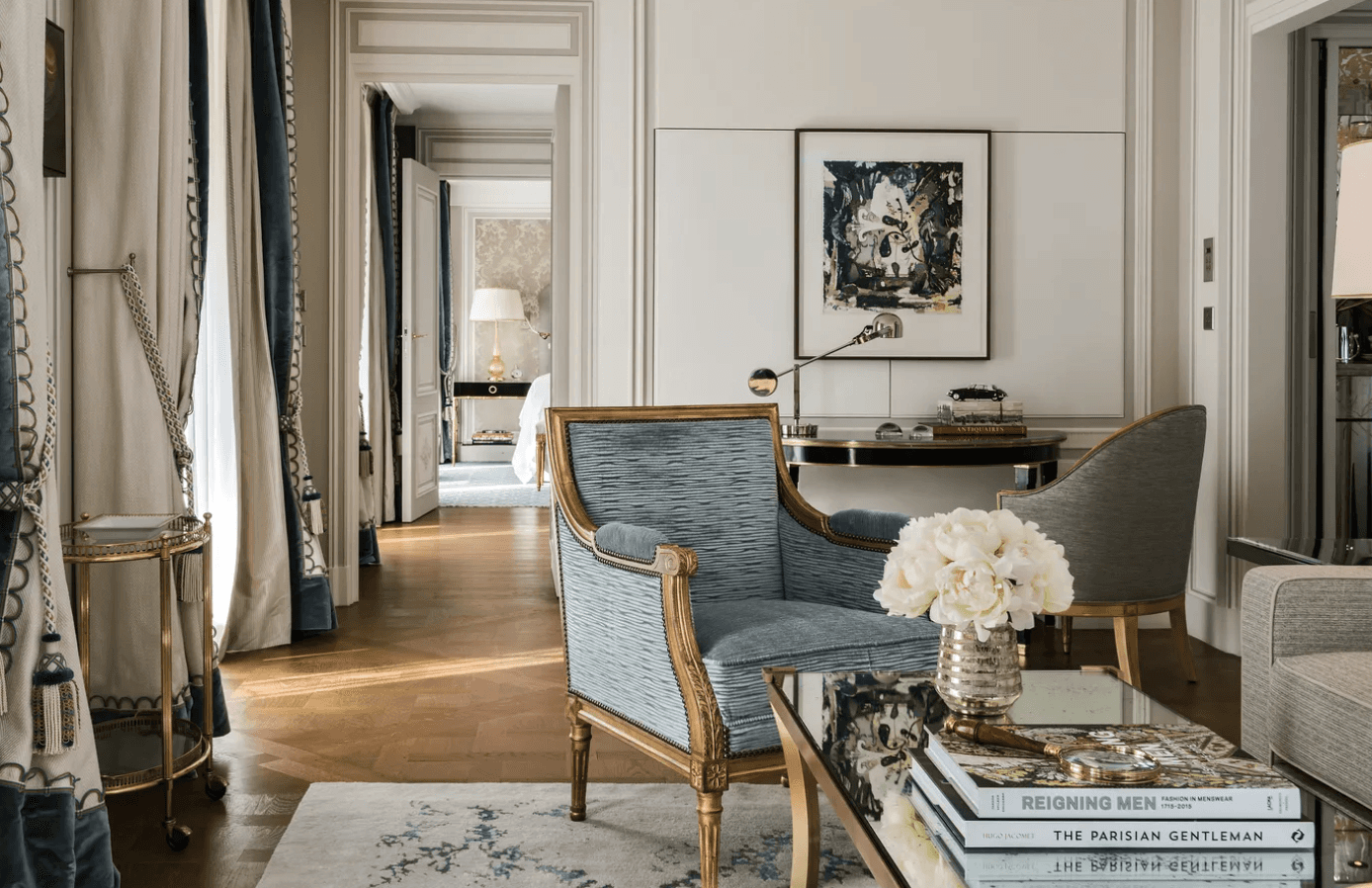
Hôtel de Crillon, A Rosewood Hotel
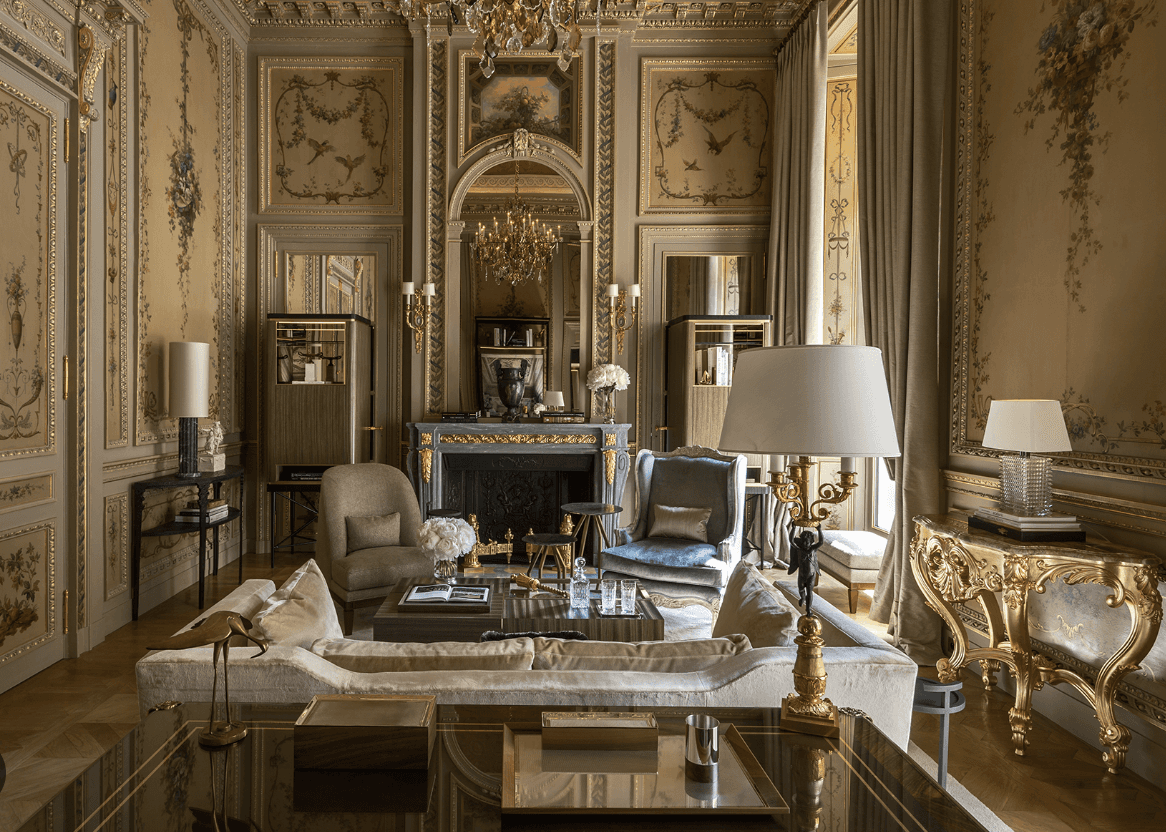
Hôtel de Crillon, A Rosewood Hotel
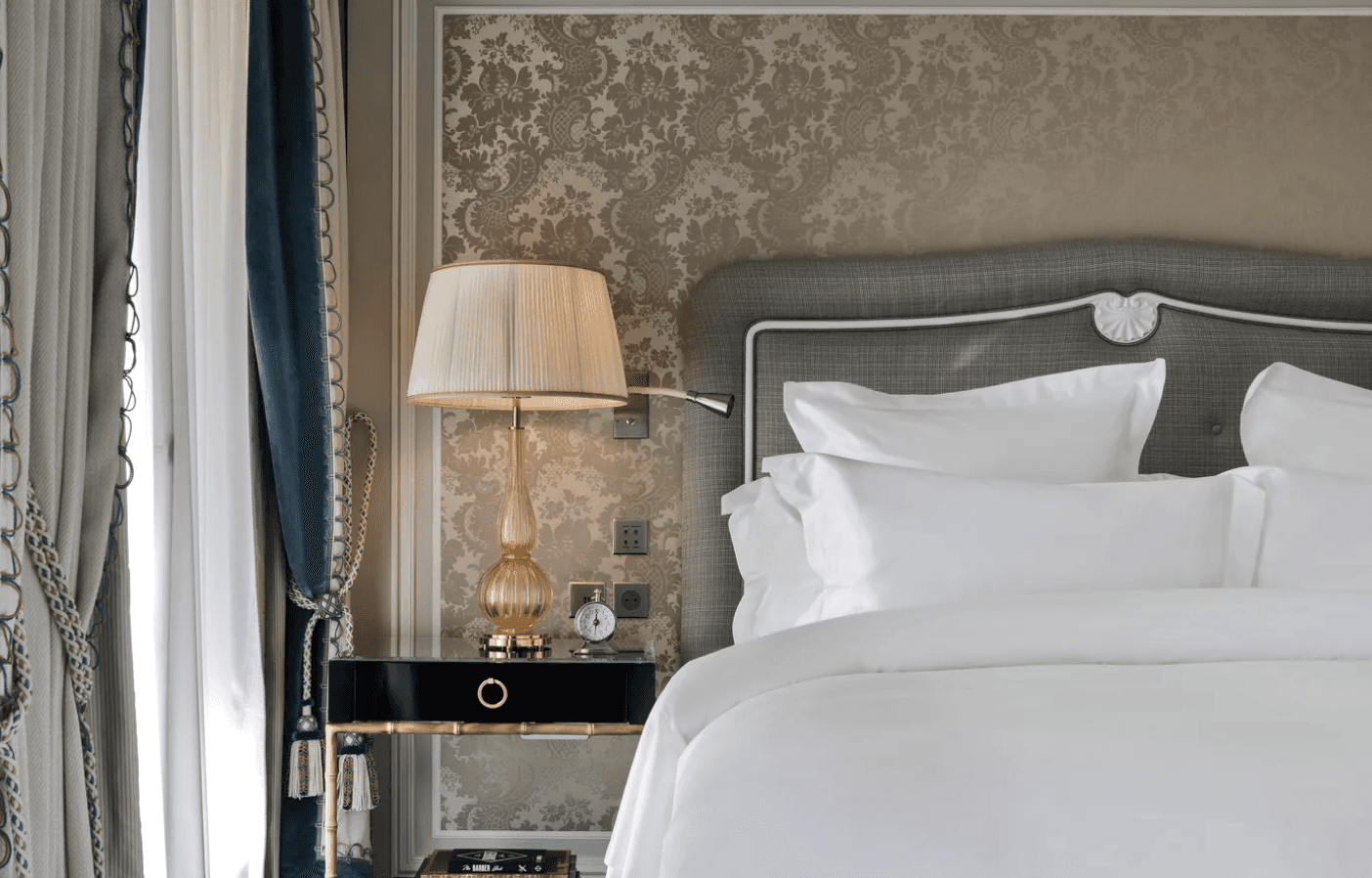
Hôtel de Crillon, A Rosewood Hotel
Hôtel de Crillon, A Rosewood Hotel
After an extensive and highly anticipated refurbishment, one of Paris's most beloved palace hotels has undergone a complete makeover. Her elegant 18th-century heart continues to beat briskly, but her pulse is quickening with the fresh 21st-century additions of sass, fizz, and zing.
One of the most luxurious hotels in Paris has been located in the 18th-century former Duke de Crillon home for more than a century, having been originally commissioned by King Louis XV. Things got even more extravagant in 2017 when the iconic establishment reopened as a Rosewood hotel. Under the direction of renowned Lebanese architect Aline Asmar d'Amman, a four-year transformation preserved the hotel's historic soul and gilded style while adding all the modern conveniences that modern travellers require.
Elevated public areas lead beyond the landmarked exterior, with a Corinthian column and Coustou statues, to 124 residential-style apartments and suites that pay homage to the mansion's former occupants. Discover a blend of handcrafted artwork, hand-picked objets d'art, antique and customised furnishings (such as bar carts in the old style), and modern accents like Bluetooth sound systems and 48-to 55-inch TVs. The 10 Specialty Suites elevate the experience to a higher level with their expansive living and dining spaces and more lavish furnishings, For example, the Suite Bernstein, named for the renowned composer, has an expansive terrace with views of the Place de la Concorde and the Eiffel Tower, while the Suite Duc de Crillon features original 18th-century woodwork from what was once the Crillon family chapel (the rest of the panelling currently resides at the Met in New York).
The warm and lively Nonos & Comestibles, a brasserie and deli run by triple-starred chef Paul Pairet, is a popular spot for all-day dining and pastry. Other culinary options include the cosy, one-star L'Ecrin, where Chef Boris Campanella's sophisticated pairing experiences let wines dictate the menu. The newest addition to the hotel's menu, Butterfly Pâtisserie, offers pastries for takeout or an extravagant tea time experience. Head pastry chef Mathieu Carlin creates all of the sweets particularly for this location.
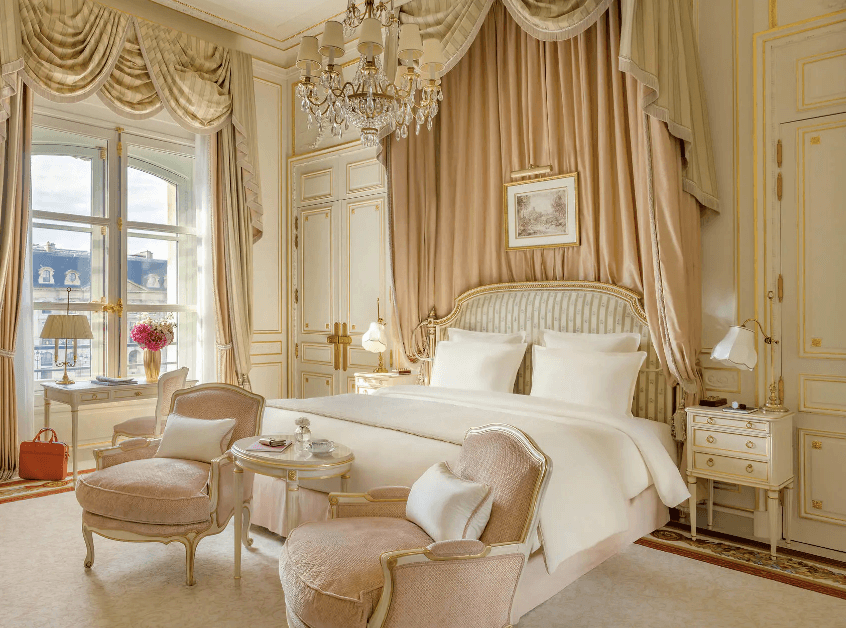
The Ritz
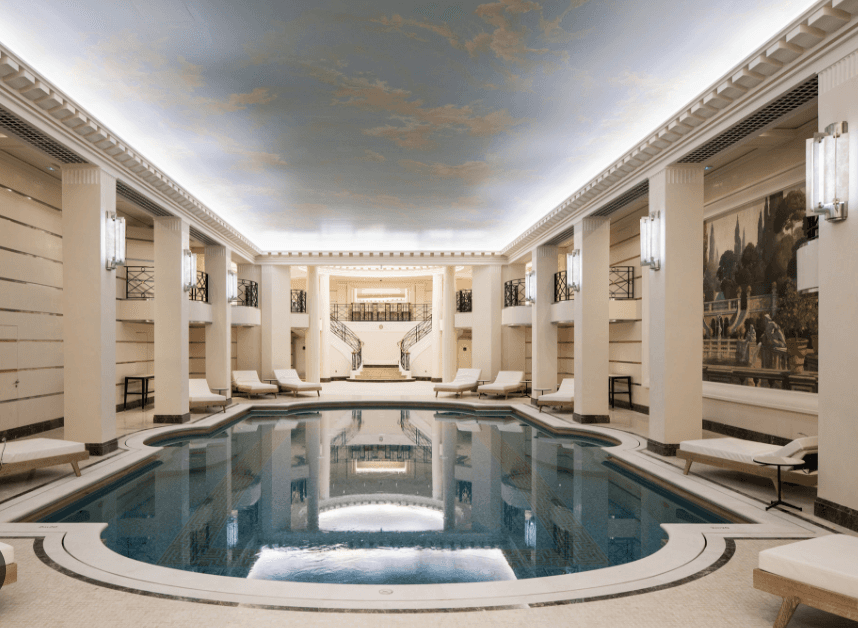
The Ritz
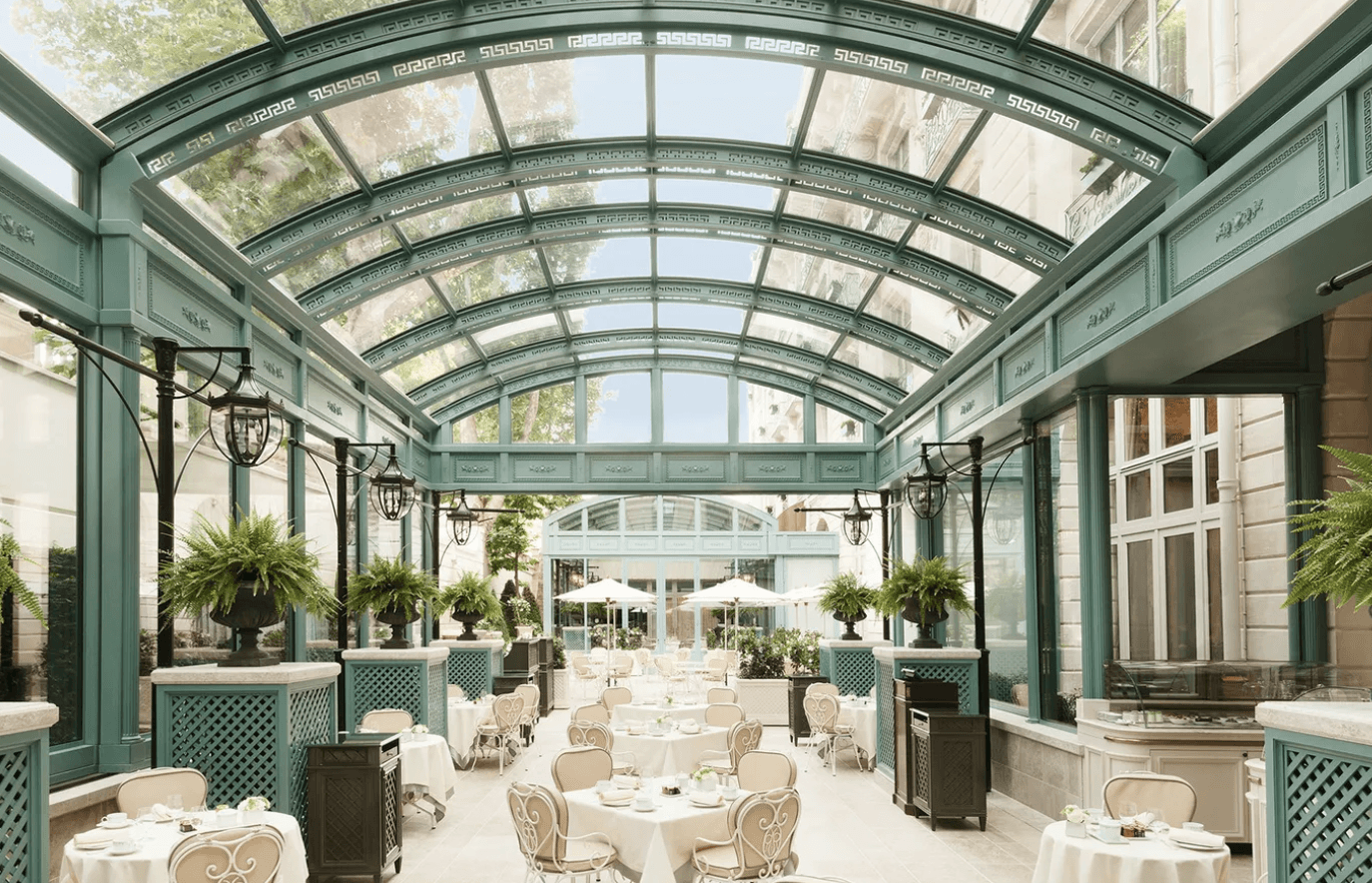
The Ritz
The Ritz
With the help of French chef Auguste Escoffier and Swiss hotelier César Ritz, one of the most opulent hotels in the world was opened in 1898. At the time, each room had electricity, a private toilet and a telephone. Over the years, the Ritz became the preferred choice for many, including monarchs, queens, Marcel Proust, and Coco Chanel, who spent 34 years there. A suite is named after Chanel, and another frequent guest, Ernest Hemingway, is honoured on two other rooms and a bar. But even an icon needs a change of pace, so the hotel shuttered for the first time in its existence in 2012 and reopened four years later with new amenities, modern technology, and a lighter, brighter, yet still opulent aesthetic. There's still the big staircase winding up from the foyer, plenty of chandeliers and tufted seats, and staff members standing at attention in their uniforms.
With a colour palette of creams and light pinks or blues accentuated by rich brocades, Louis XV furniture, pastoral oil paintings, chandeliers, and trademark touches like key-shaped light switches and silk tulip lampshades, the 142 rooms and suites are spacious and exquisite. The Marcel Proust suite has a wall of vintage books, while the F. Scott Fitzgerald suite has a collection of global mementos. Each Prestige Suite is designed to honour its namesake. While most suites and rooms on higher floors include balconies or patios, all rooms feature marble fireplaces.
You may treat your taste senses in a number of locations, such as the glass-ceilinged Bar Vendôme brasserie, where you can try the Japanese breakfast in the morning, or the Salon Proust, which serves a sumptuous afternoon tea complete with deliciously spongey Madeleines.
If you're impressed by what you've tasted, enrol in a lesson at the L'Ecole Ritz Escoffier cooking school to improve your culinary skills (children's programmes are also available). Arrive early to the consistently crowded Bar Hemingway to get a spot, then indulge in some excellent people watching while sipping drinks. The Ritz Bar, which opened in September 2021, is a spectacular place with a lantern ceiling that serves glitzy drinks created by rising star mixologist Romain de Courcy, which are influenced by astrological signs.
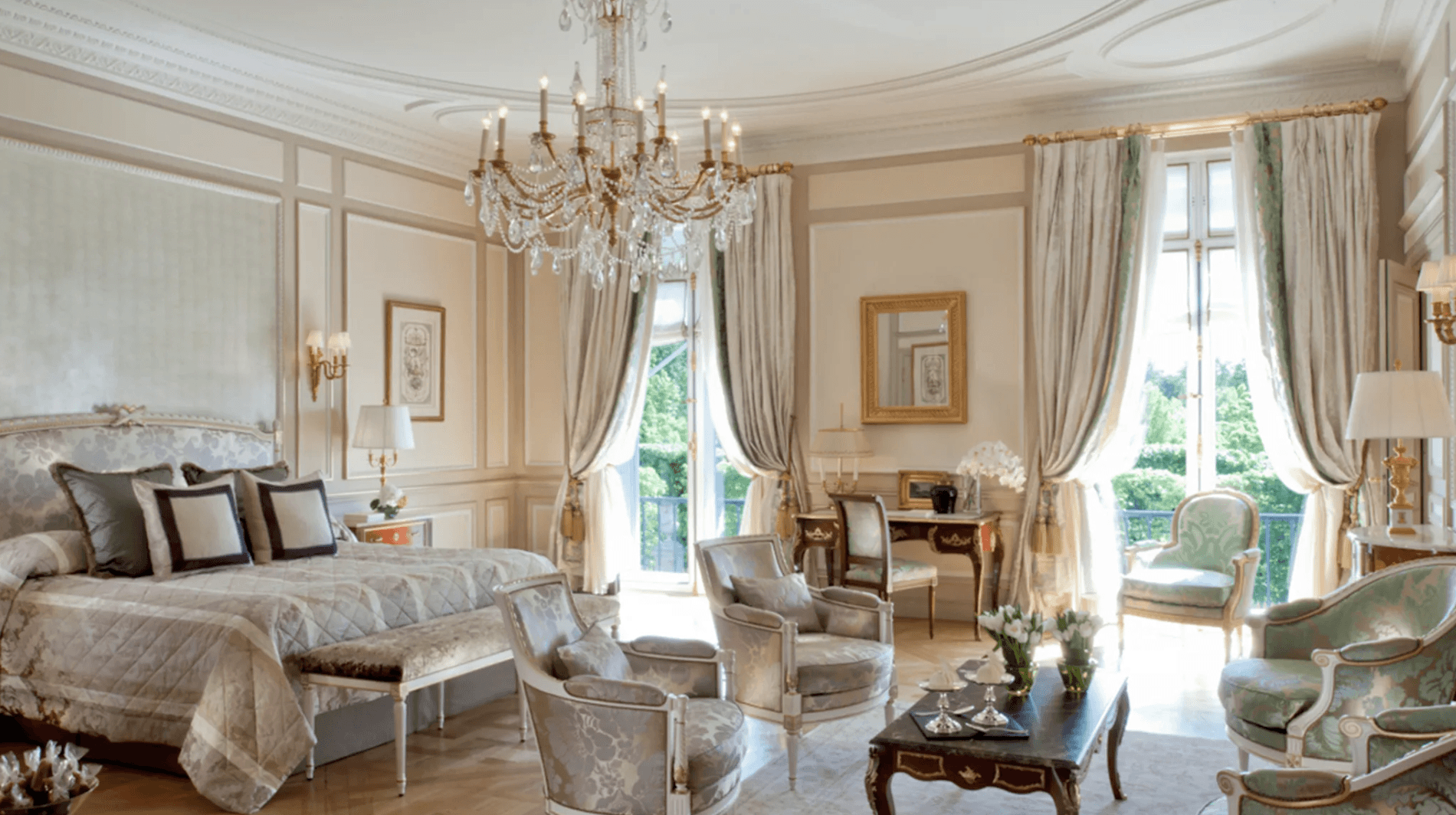
Le Meurice, Dorchester Collection
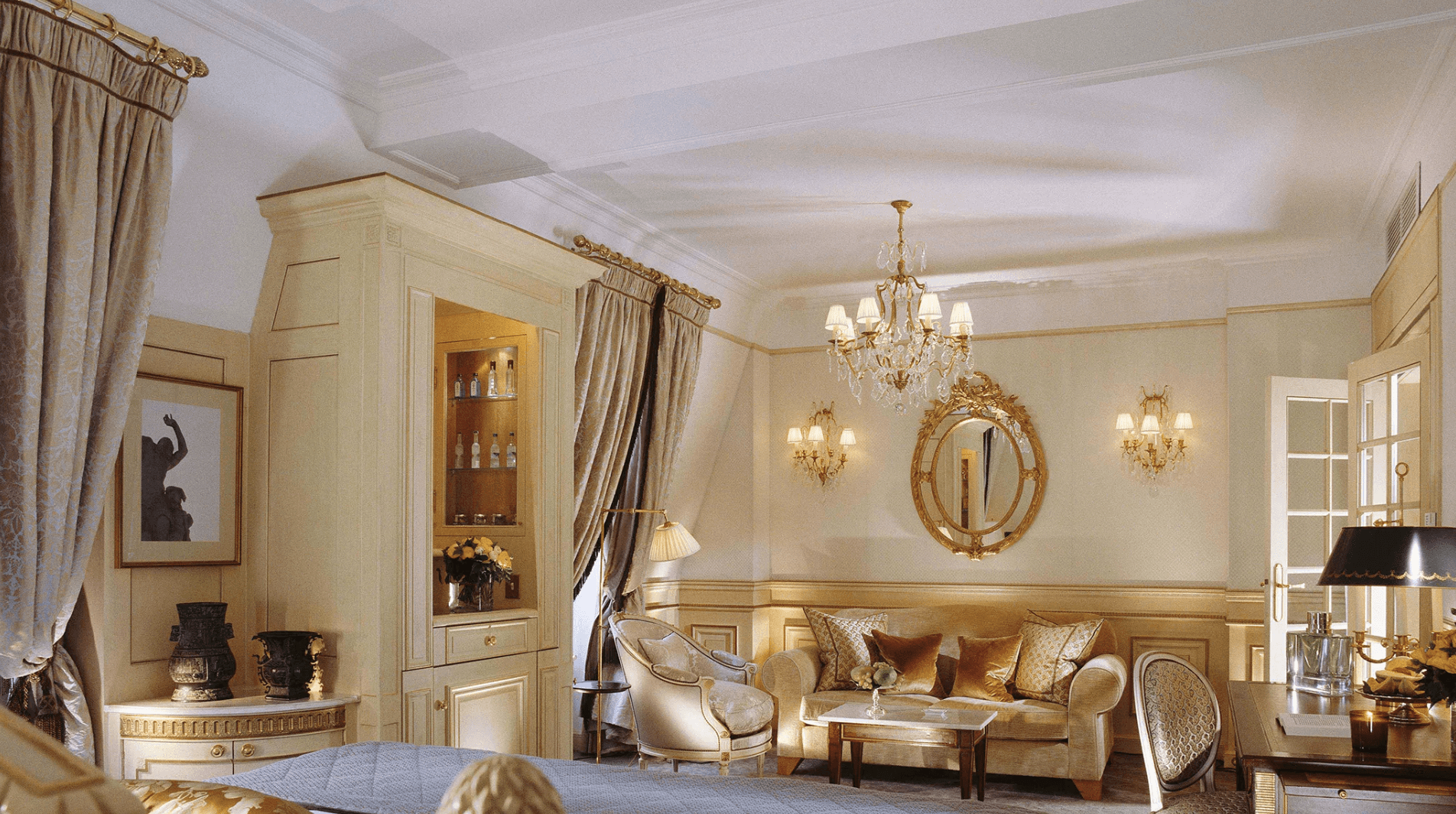
Le Meurice, Dorchester Collection
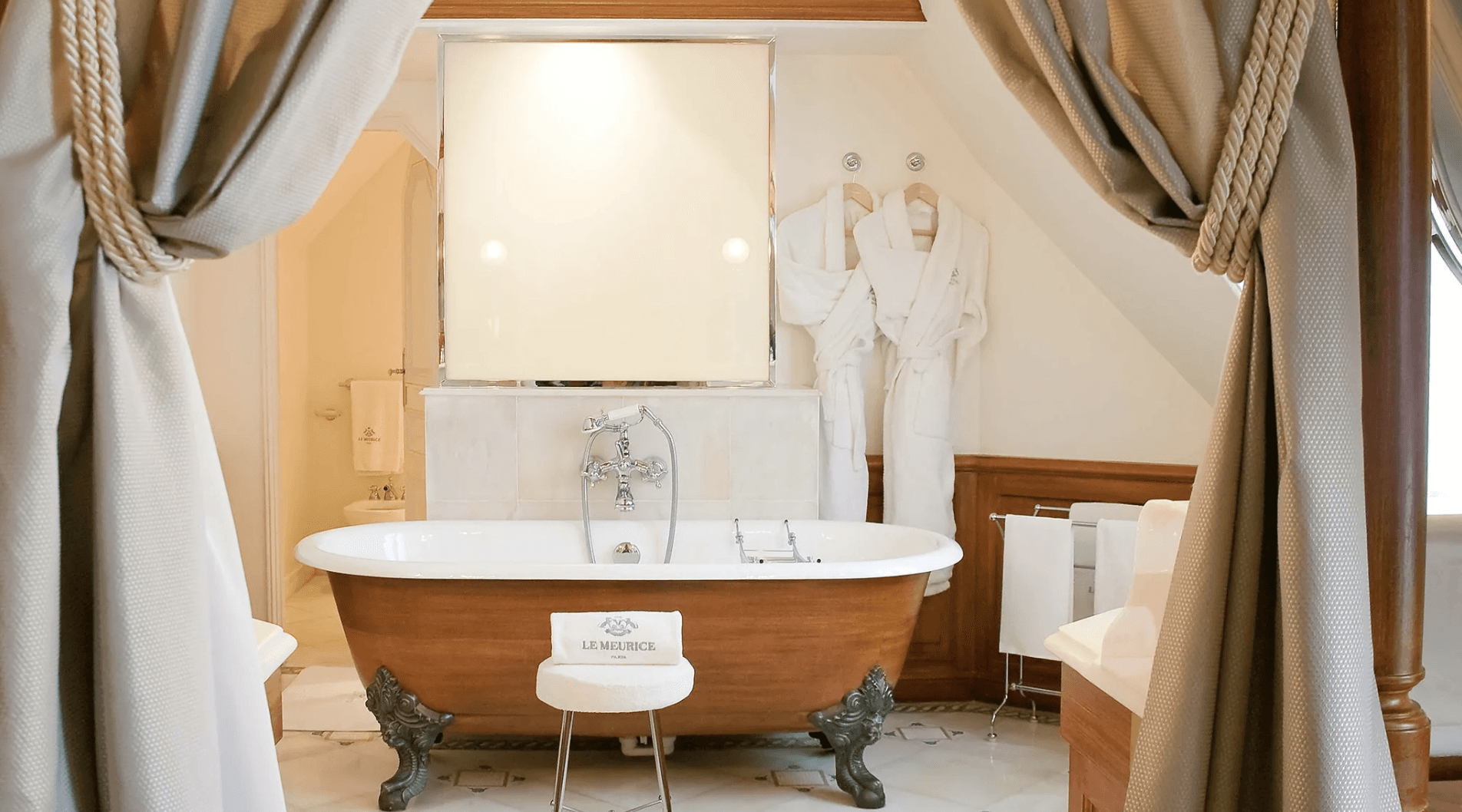
Le Meurice, Dorchester Collection
Le Meurice, Dorchester Collection
Le Meurice is what you get when you imagine 18th-century luxury filtered through a Salvador Dalí artwork. Located near the Tuileries Garden, this renowned location was formerly home to Picasso's wedding feast and, most famously, was the residence of Salvador Dalí for more than thirty years. It debuted as one of the world's first luxury hotels in 1815. Knoll's Eero Saarinen Tulip chairs and portraits of 18th-century figures painted on the backs of leather seats are examples of classic elements that are balanced against the whimsical design of Dalí, which father-daughter design duo Philippe and Ara Starck looked to when renovating the Dorchester Collection hotel in 2016.
All of the rooms and suites of Charles Jouffre's hotel have been decorated in a French classical style, complete with plush carpets, classic furniture, antique accents, and fresh flowers. One unusual room even features a gabled ceiling and views of a peaceful courtyard. The design company Lally & Berger updated a number of lodgings between 2016 and 2019, giving the rooms a light, Versailles-inspired aesthetic. New suites were also shown, such as the four-bedroom duplex Belle Epoque, which boasts an unending rooftop patio and a Jacuzzi with views of Montmartre, and the Pompadour Suite, which has regal features like secret doors, a fireplace, oak parquet flooring, and custom carpets and furnishings.
The master chef exhibits his "Essential Cuisine" concept in the Michelin-starred Restaurant Le Meurice Alain Ducasse, while Le Dalí Restaurant specialises in hyper-seasonal and locally sourced French cuisine. Regulars fill Bar 228 with concoctions mixed by the renowned barman William Oliveri, among plush leather couches, dark wood panelling, jazz music and massive 1907 Lavalley murals. The results-driven products from Swiss brand Valmont are used in the jewel-box spa.
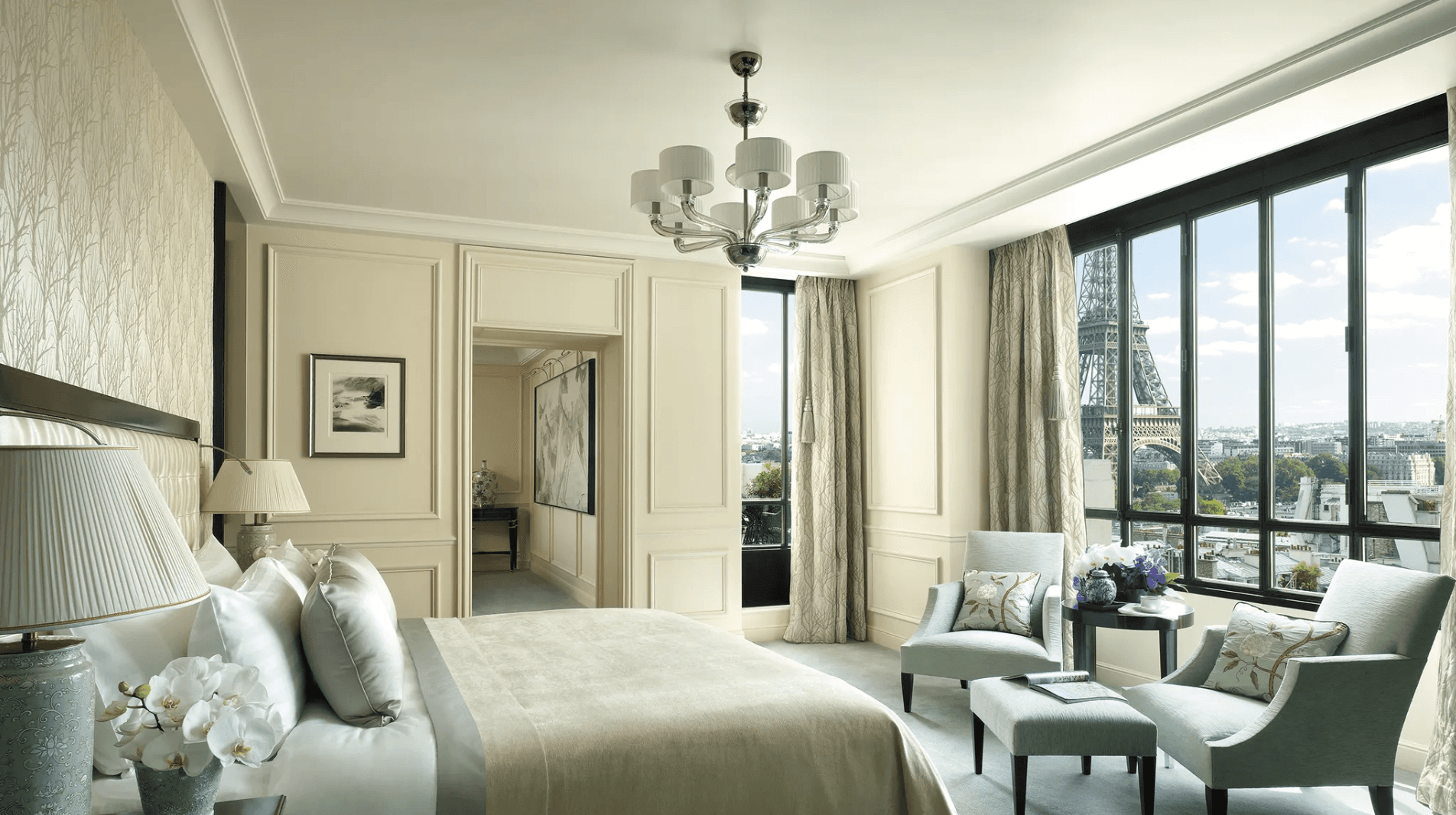
Shangri-La Paris
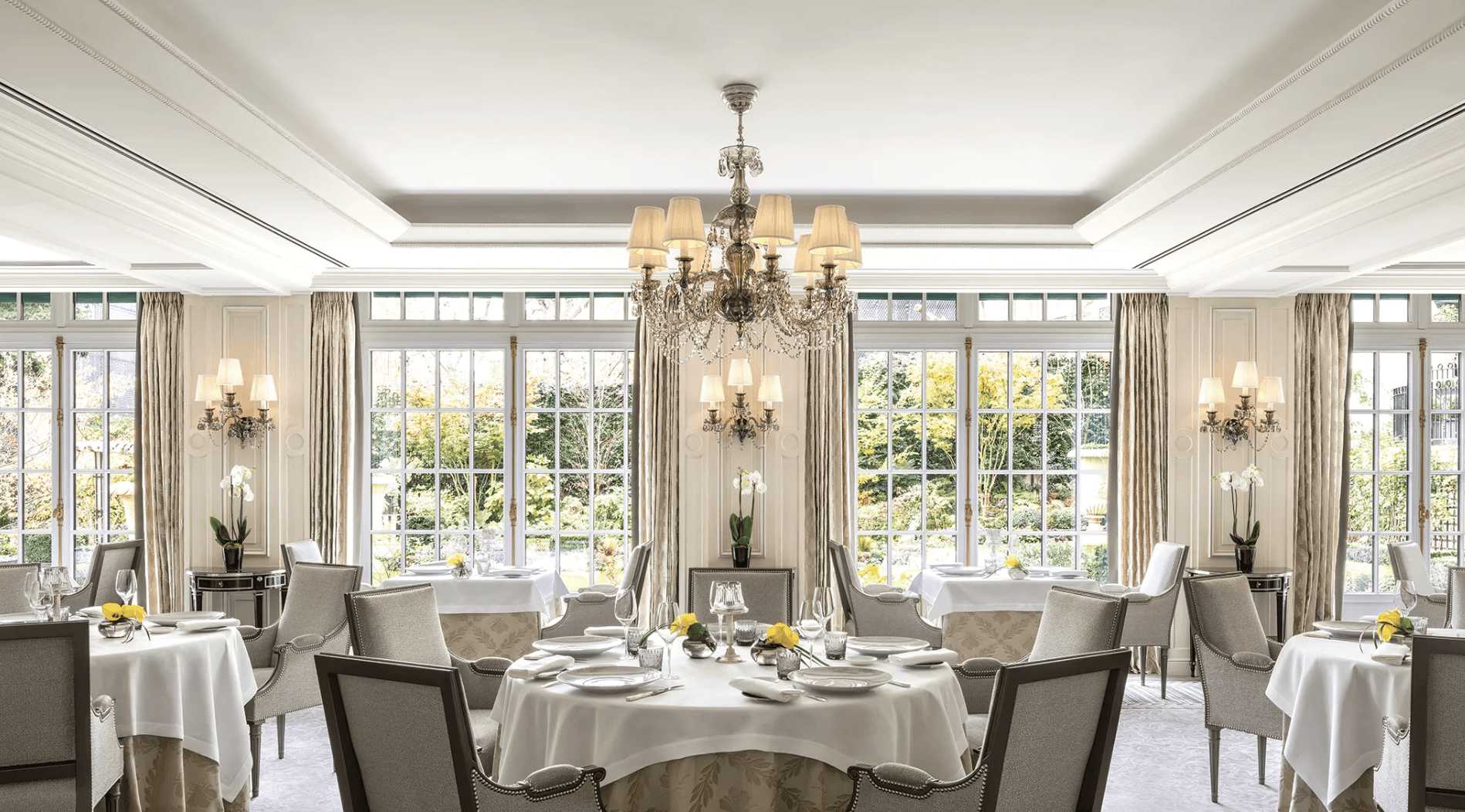
Shangri-La Paris
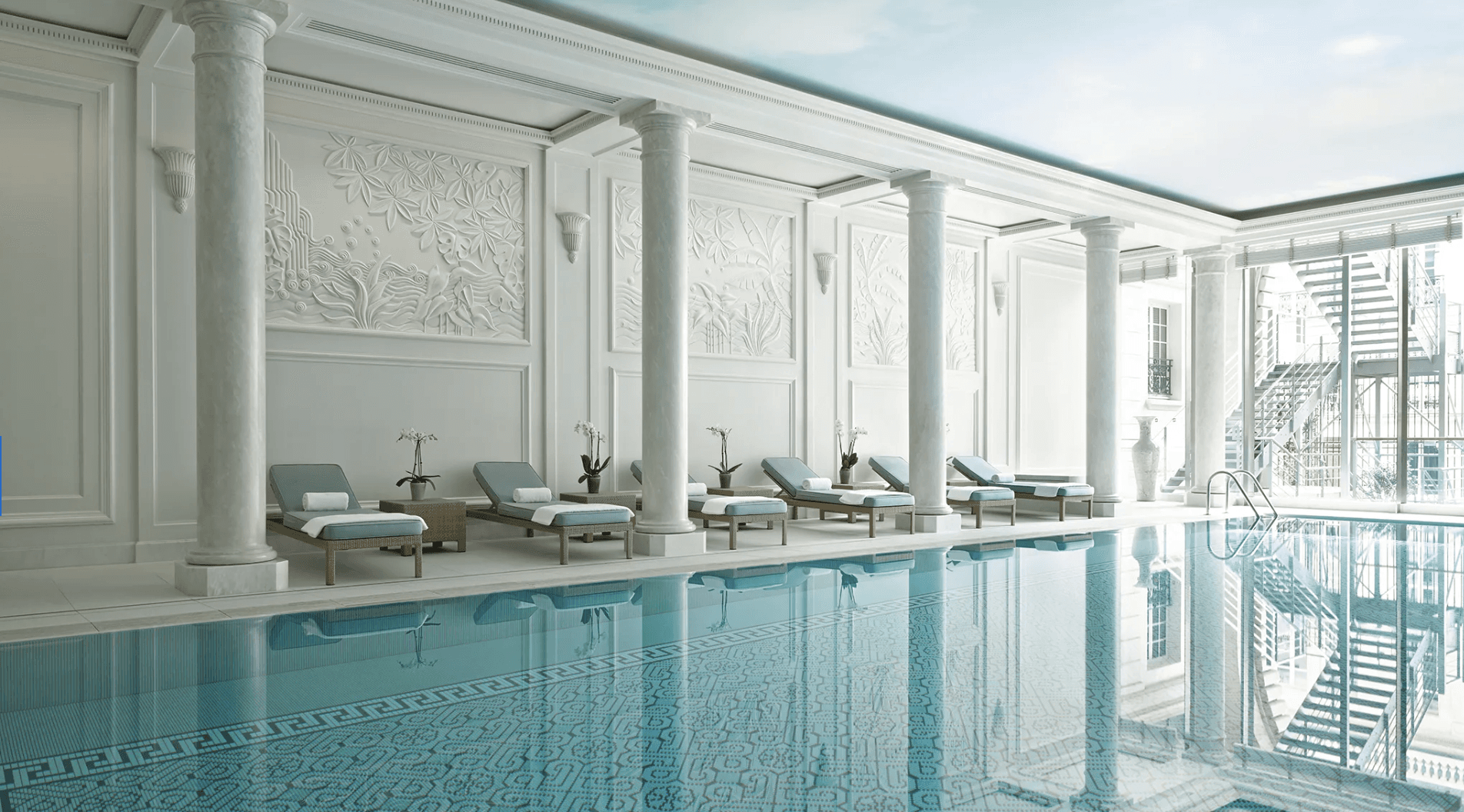
Shangri-La Paris
Shangri-La Paris
Napoleon's great-nephew, Prince Roland Bonaparte, selected a prominent location near the Seine River in 1891 and built a magnificent mansion with a spectacular "Stairway of Honour" fashioned from brass and forged steel, an intricately carved façade, and a vaulted ceiling decorated with zodiac symbols. The elegant prince was well-connected in Parisian intellectual, scientific, and artistic circles. He also held several exciting events at his castle, a custom that was brought back to life in 2010 with the inauguration of Shangri-La Paris. The structure was revitalised as well; following years of painstaking restoration work, it is now recognised as a historic landmark and has original wood flooring, stained glass windows, hand-carved mahogany panels, a marble entryway with a domed top, and the renowned staircase.
Given that half of the hotel's 100 rooms and suites have terraces and nearly all of them have views of the Eiffel Tower (some even from the bathtub), it should come as no surprise that this is a popular destination for anniversaries, honeymoons, and proposal ideas. The rooms have a cosy, domestic feel thanks to custom furniture, handy technology, and an Asian-meets-European design, which is represented in details like textured panelling and silk-thread wallpaper.
The marble bathrooms have heated floors, flat-screen TVs set into the fog-free mirrors, and both walk-in showers and deep soaking tubs—two ways to use the Guerlain bath products. The best part is that a lot of them have windows to bring in natural light and show off the views of the Eiffel.
The hotel is home to two of the city's most popular eating destinations: Shang Palace, the first Michelin-starred Chinese restaurant in France, and La Bauhinia, which provides a sophisticated East-meets-West cuisine that includes the well-liked afternoon tea, under the central glass cupola. Taking its name after Prince Roland's preferred field of study, the swanky Le Bar Botaniste offers a selection of uncommon botanical alcoholic beverages, complete with an absinthe fountain. Located in the ancient stables of the castle, the spa soothes with lovely indoor pool and scented treatments.
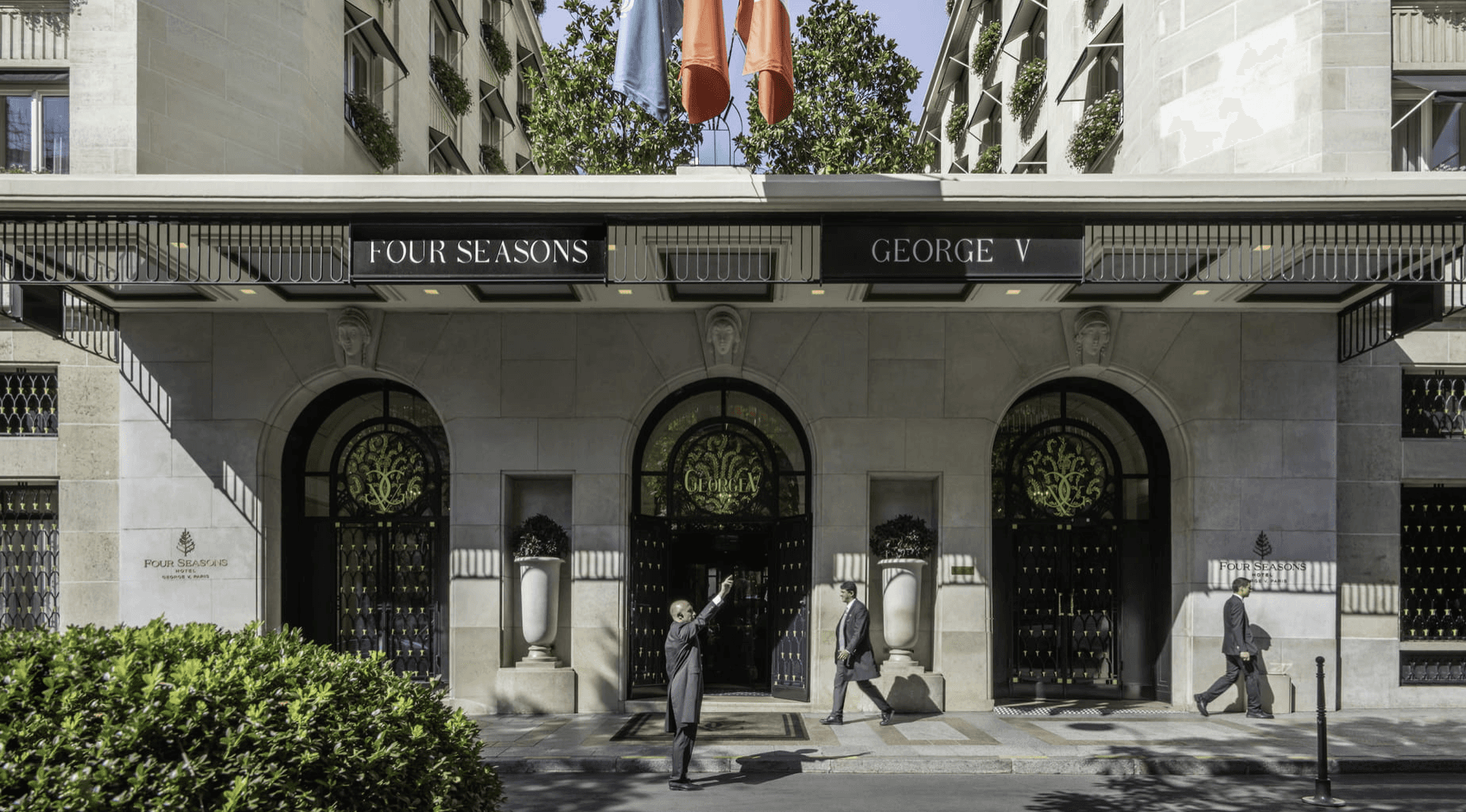
Four Seasons Hotel George V, Paris
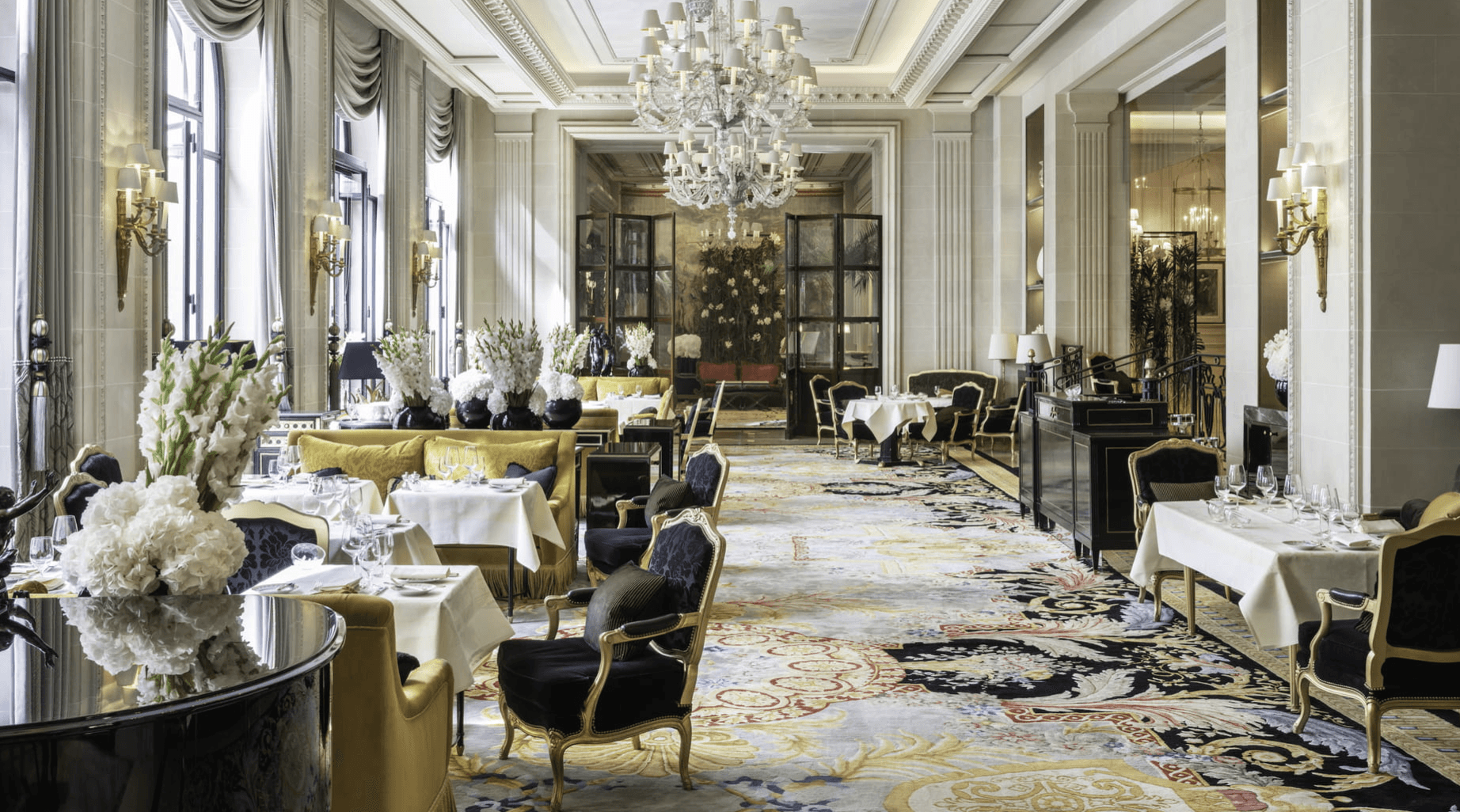
Four Seasons Hotel George V, Paris
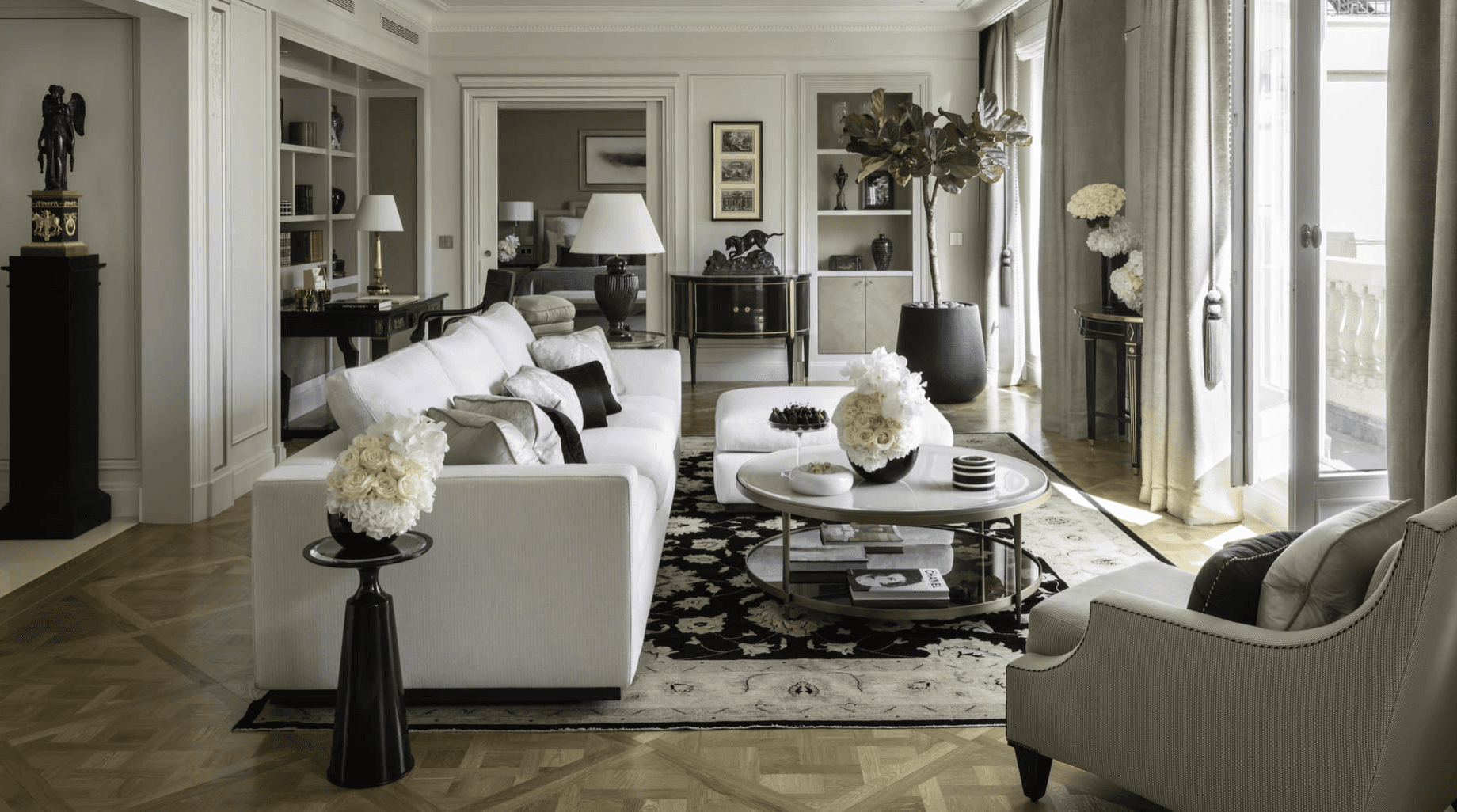
Four Seasons Hotel George V, Paris
Four Seasons Hotel George V, Paris
This hotel is a true Paris institution, having debuted in 1928 and situated in the ever-so-chic eighth district. However, as soon as you walk in, you realise that things are not as conventional as they appear. Although the staff is kind and professional (and always knows your name), the big and gilded foyer prevents the establishment from being stuffy. Instead, it is infused with modern flair and an edgy attitude. For example, consider the striking lobby installations by renowned florist and designer Jeff Leatham, which might feature enormous plexiglass reindeer in the winter or exquisite, toppling flower arrangements in the spring. Pop-ups in the courtyard, such as a winter 'igloo' with an ice bar, give the location a lively vibe that sets it apart from many other hotels with palace designations.
The 244 rooms and suites are the ideal Paris pied-à-terre, complete with a living room decorated in the Louis XVI style, an enormous walk-in closet, and separate bathrooms with views of the Eiffel Tower. Even the entry-level categories are rather roomy by city standards, with a traditional décor of Louis XV-style furniture, subdued colour palettes, and (for the most part) balconies or patios. The suites, on the other hand, are full of enchanted details; depending on the kind, you may make supper for six people in your fully equipped kitchen, enjoy chandeliers and walls covered in fabric, or toast with champagne on the terrace of your duplex.
With double vanities, big bathtubs, power showers, and thick terry cloth robes, the marble bathrooms are spacious and provide plenty space for unwinding. Aromatherapy pods are available for some of the showers, and they may be fixed to the nozzles to create a soothing sensory experience.
This is Europe's first hotel with five Michelin stars under one roof, earned by three separate restaurants. There's the fine dining Le Cinq, where French classics are recreated with lighter ingredients and techniques; the colourful and trendy Le George, with Mediterranean-influenced dishes and plenty of half-portion options; and the exquisite L'Orangerie, which serves contemporary Gallic cuisine. All restaurants use top vintages from the hotel's famed, approximately 50,000-bottle cellar, which was able to withstand World War II bombardment thanks to its location 45 feet underground. High tea is served in La Galerie, surrounded by 19th-century paintings and Flemish tapestries, while cocktails and single malts may be drunk in the wood-paneled Le Bar, which overlooks the tree-lined Avenue George V. The spa has a hair salon, a high-tech gym, and treatments utilising high-end Swiss skin care products; a pool, sauna, and steam hammam complete the soothing experience.
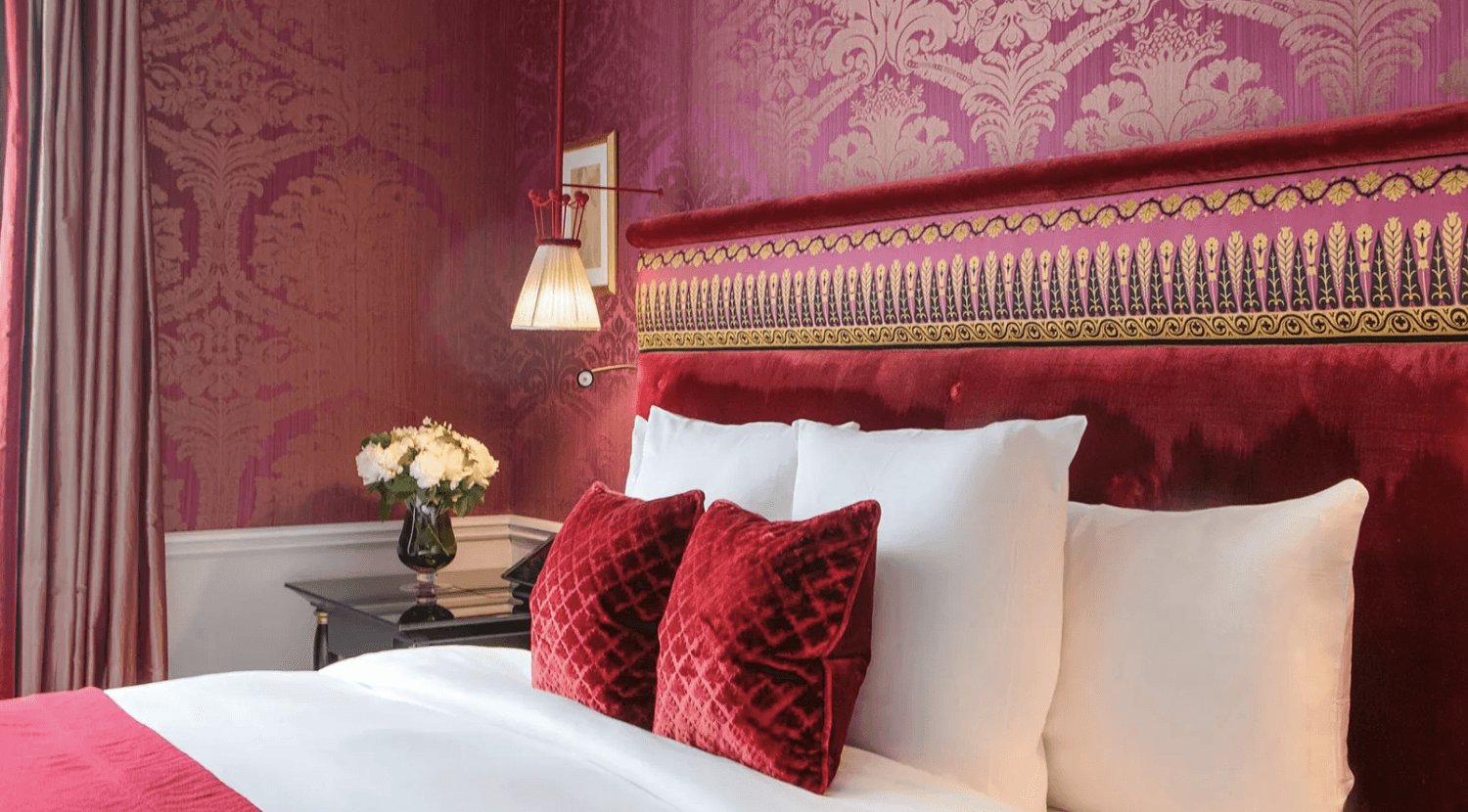
La Réserve Paris - Hotel and Spa
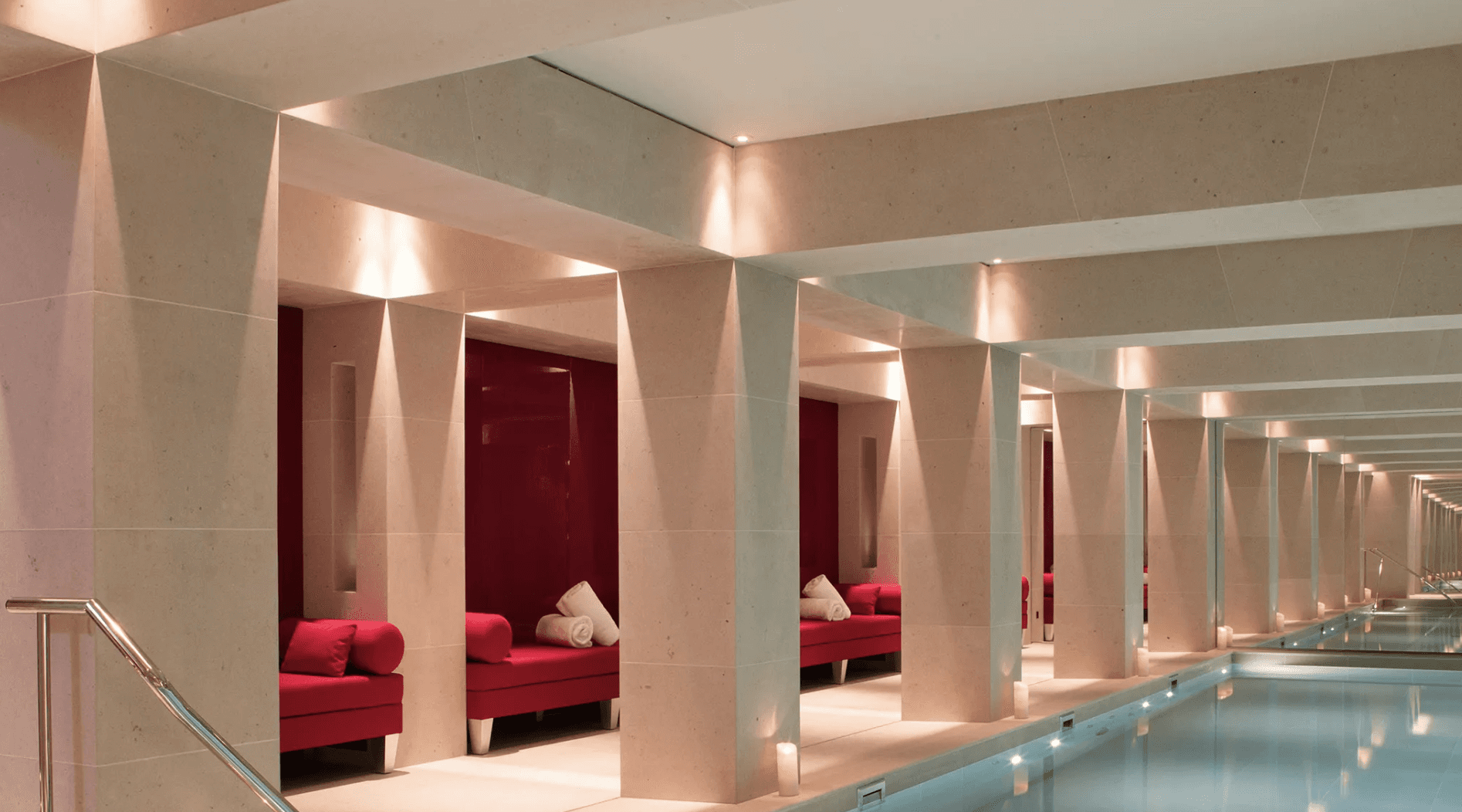
La Réserve Paris - Hotel and Spa
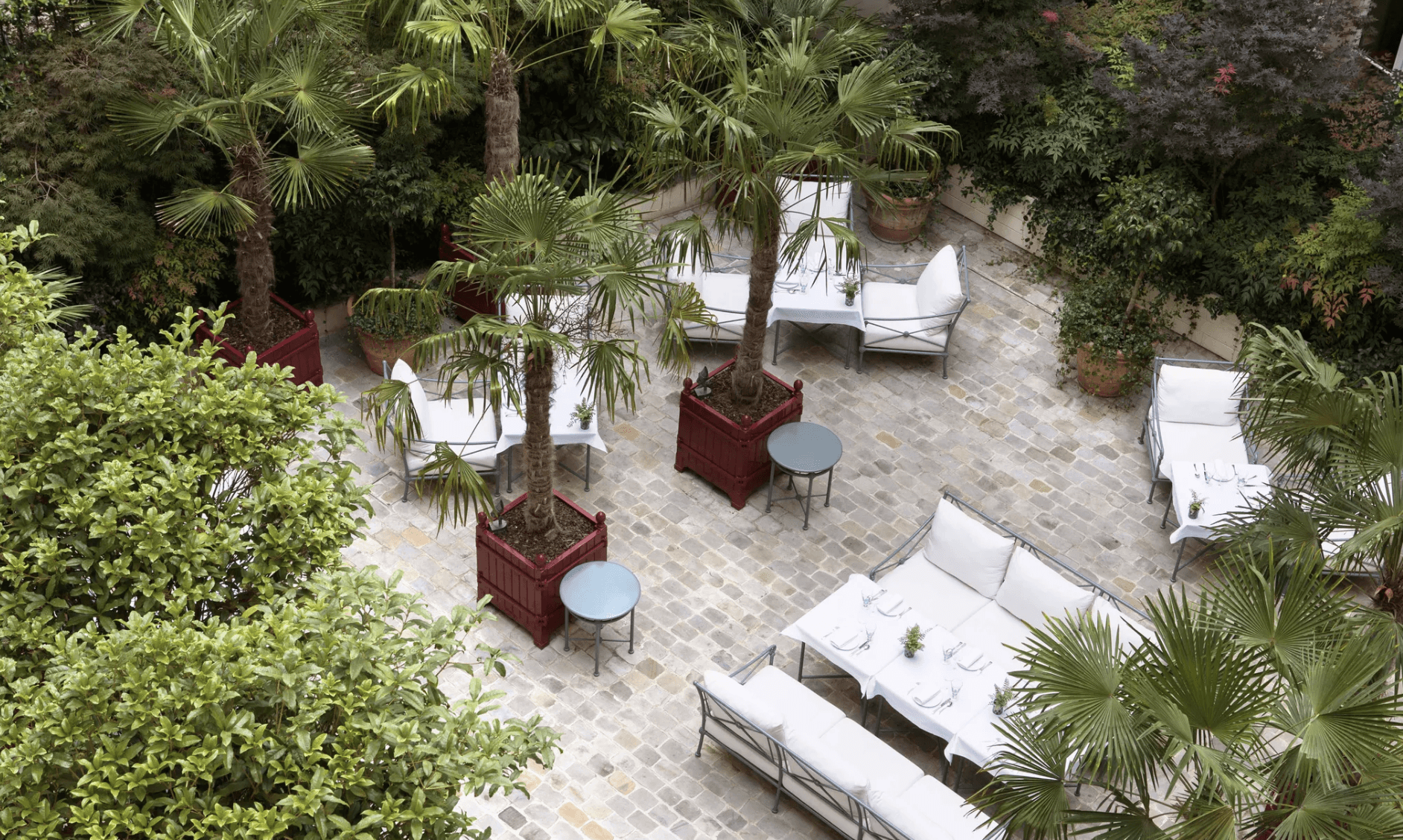
La Réserve Paris - Hotel and Spa
La Réserve Paris - Hotel and Spa
Past the Haussmann-style façade and a flaming red entrance, you enter a world of elegant 19th-century beauty combined with fully contemporary accents. La Réserve Paris, which opened in 2015 in a palace originally owned by Napoleon's stepbrother, the Duc of Morny, was designed by interiors master Jacques Garcia in his characteristic style, with plenty of velvet draperies, silk damask walls, gold frames, and herringbone parquet flooring. The public areas encourage relaxation, with long, pillow-strewn sofas and plush upholstered club chairs arranged around ornate fireplaces and shelves lined with over 3,000 antique books; an intimate garden lounge makes the city seem far away, despite the property's proximity to the Champs-Élysées and Avenue Montaigne.
Electronic check-in and iPad control centres for temperature, lighting, and entertainment in the rooms help to counter the dreamlike extravagance. The décor varies throughout the 40 rooms (more than half of which are suites), but is usually more subdued than the lobby areas, with neat, plain beds complemented with velvet arm chairs, hand-picked antiques, and billowing damascene brocade taffeta. Many feature floor-to-ceiling windows or private patios that overlook metropolitan landmarks.
The enormous bathrooms, which are filled with natural light, are finished in Carrara and Turquin blue marble and have double vanities, separate tubs, and Italian showers.
The details are what really stand out, from linens embroidered with guests' names and a jewellery box in the hotel's distinctive deep red to different colours for men's and women's bathrobes (slate for him, blush for her), and hand weights and stretch bands provided for in-room exercise. Mini-bars stock wine from the hotel's estates. Each room has a butler who will make sure your bedside tables are stocked with books by your favourite authors, draw you a bath, or assist you with packing, and who can also organise exceptional events such as in-suite private concerts, couture fittings, and custom perfume creation sessions.
Given the hotel's tiny size, the recreational amenities are substantial: a 52-foot lap pool, a gym with personal trainer, and a three-room spa with customised treatments from the Nescens-Swiss anti-aging brand. The two-Michelin-star Le Gabriel reinterprets classic French fine dining with a Japanese twist, whilst La Pagode de Cos reinterprets meals from across the world in a space gilded with carved woodwork and a large fireplace. The stunning Duc de Mornay Library, which will be unveiled in 2021, is only available to hotel guests in the morning before opening to the public for lunch on the patio or around the fire, tea in the afternoon (perhaps paired with one of the over 3,000 books on the shelves), and drinks from the honour bar in the evening. Be sure to taste some Bordeaux from the hotel's vineyards, and don't miss the "secret" entrance to the smoking area, which has 400 cigars. Finally, Bar Le Gaspard, a local favourite, has a large wine and cocktail selection, as well as bartenders who can build a drink according to your preferences—and will remember the recipe the next time you visit.
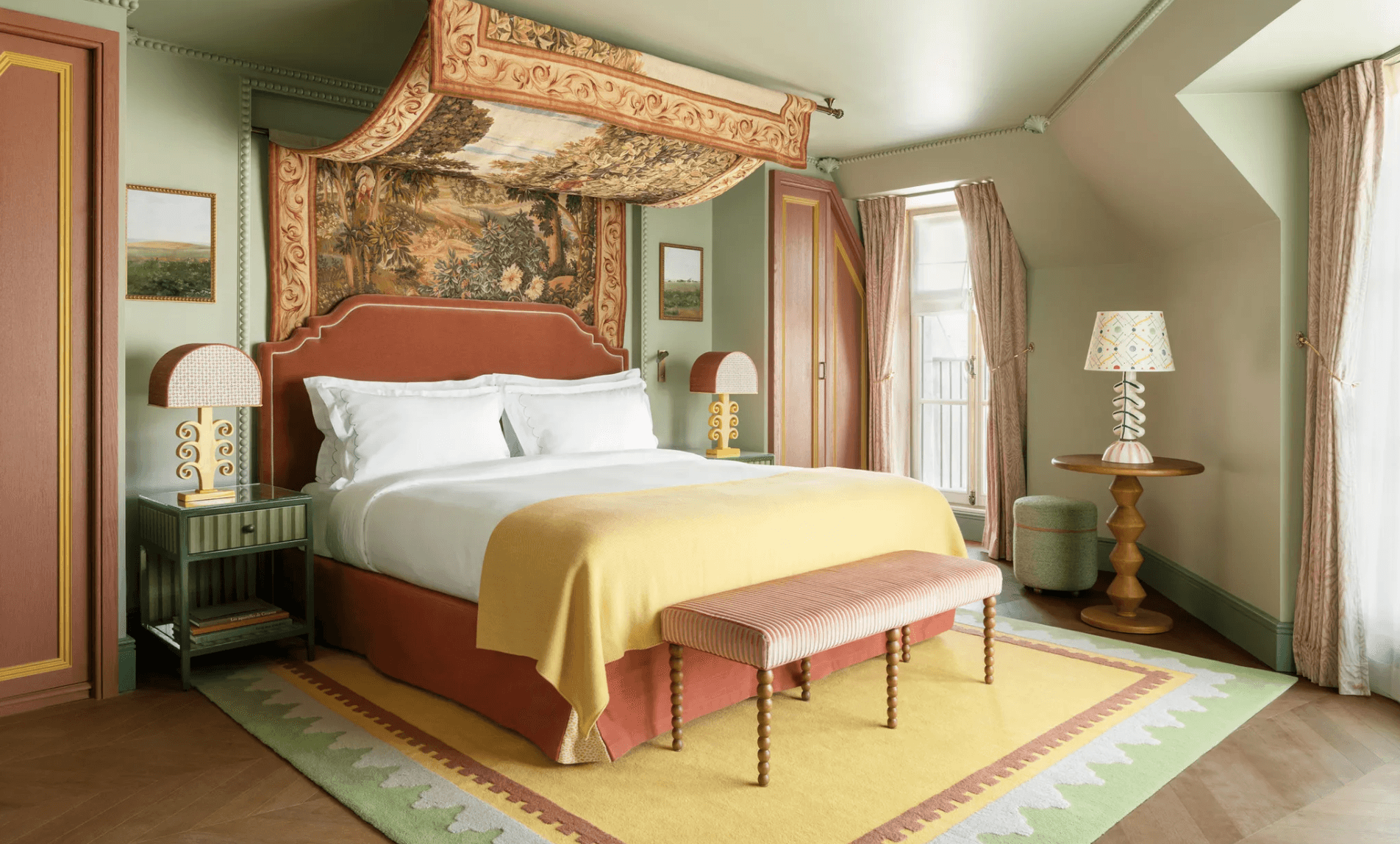
Hôtel Le Grand Mazarin
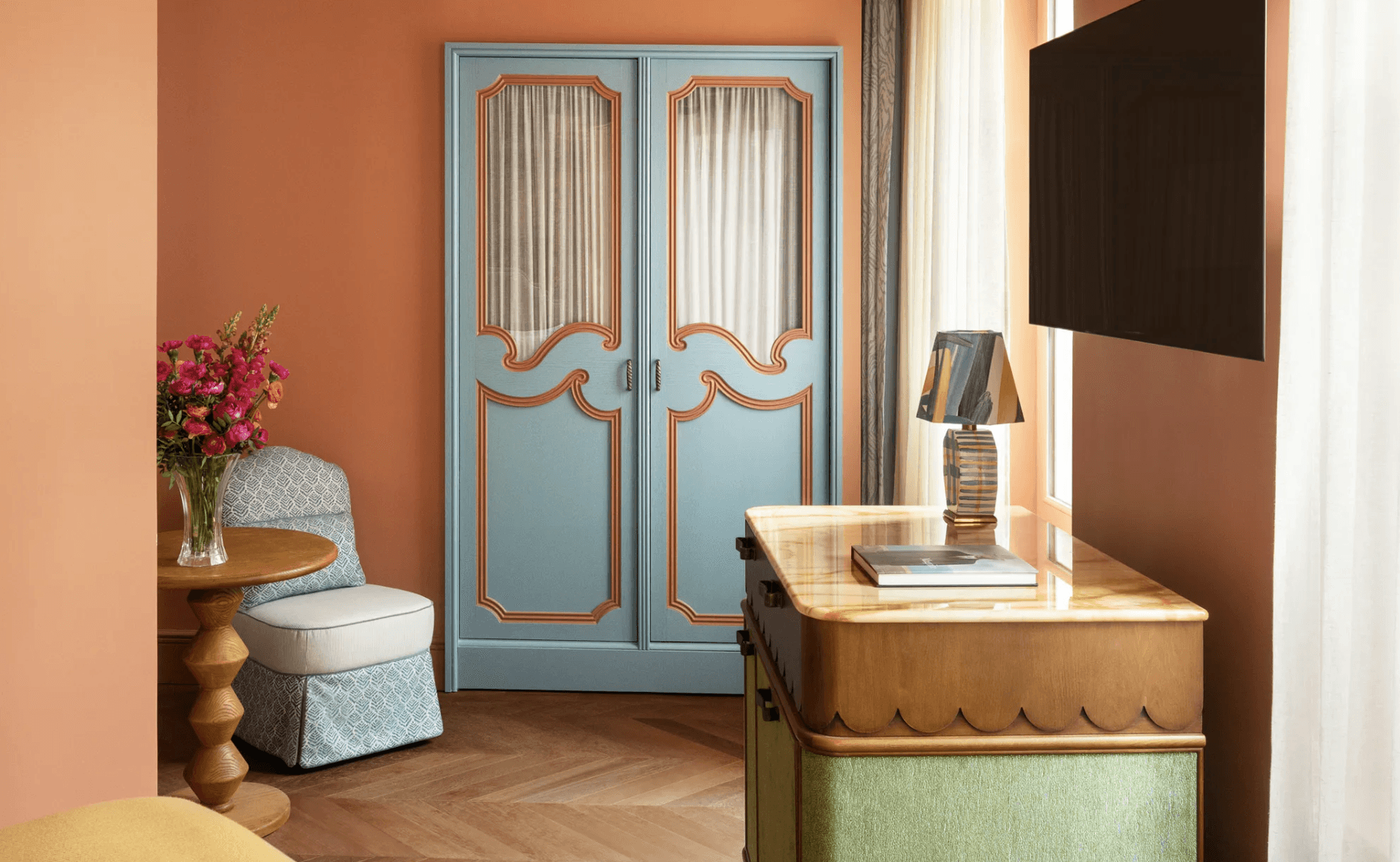
Hôtel Le Grand Mazarin
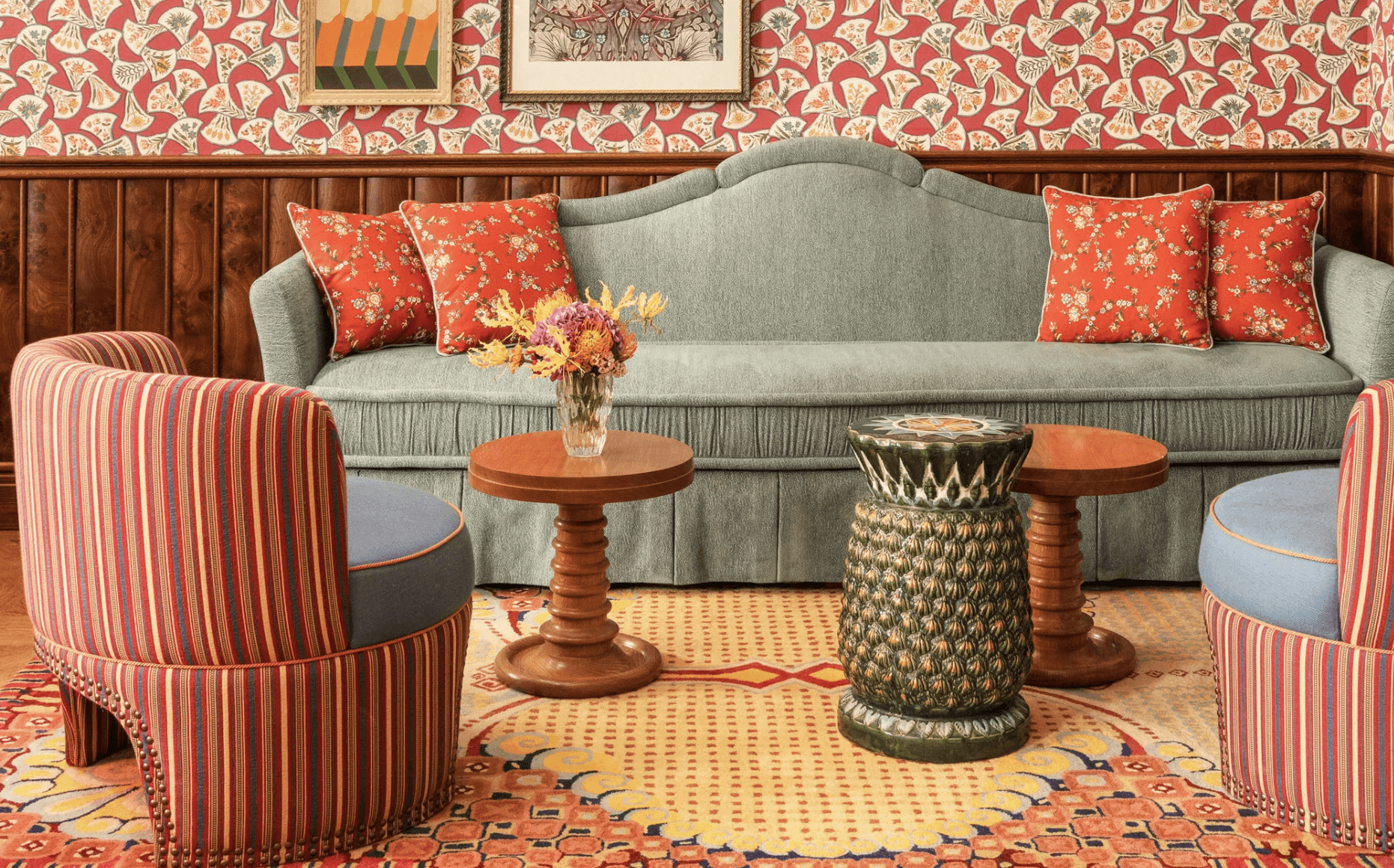
Hôtel Le Grand Mazarin
Hôtel Le Grand Mazarin
Le Grand Mazarin, from the Maisons Pariente line, stands out for its eclectic and maximalist style by Swedish designer Martin Brudnizki. Rather than being inspired by Louis XIV's minister Cardinal Mazarin, the hotel was influenced by 17th-century literary salons. The hotel, which has over 500 meticulously collected artworks by Amélie du Chalard, including trompe-l'oeil windows by Sophia Pega and a beautiful fresco by Jacques Merle, provides a compelling combination of food, beverages, and creativity. This makes it a standout location in Paris, where guests can immerse themselves in a world of culture and elegance.
The Wes Anderson meets Alice in Wonderland literary salon feel is most evident in each of the 50 guest rooms and 11 suites, some of which have individual balconies with views of the BHV/Marais and the neighbourhood. Because of the ancient 14th-century edifice they occupy, each is naturally unique in design and arrangement, but this only adds to its attractiveness. Brudnizki's take on French classicism employs disparate motifs, colours, and fabrics that work well together, aided by the craftsmanship of the talented artisans he hired to complete each piece, many of whom work for companies bearing the French Living Heritage label (Entreprises du Patrimoine Vivant). The plush carpets were created by Manufacture Pinton 1867, the quirky fabrics by Maison Pierre Frey, and the custom lamps with hand-decorated legs and shades by two different artists, Laura Horrocks and Claudia Cauville.
The design varies each room, but there are a few common threads: the room is built up around a huge bed with an Aubusson-style tapestry from Art de Lys as a canopy. Mini bars offer locally sourced snacks, coffee capsules from Café Joyeux, a French coffee shop chain that employs people with disabilities, and a selection of beauty products curated by the Parisian concept store Oh My Cream, all of which can be ordered and delivered to rooms within 30 minutes by a butler. Diptyque bath items line the vanity in every bathroom. Mini bars offer locally sourced snacks, coffee capsules from Café Joyeux, a French coffee shop chain that employs people with disabilities, and a selection of beauty products curated by the Parisian concept store Oh My Cream, all of which can be ordered and delivered to rooms within 30 minutes by a butler. Diptyque bath items line the vanity in every bathroom.
In terms of cuisine and wine, chef Assaf Granit's award-winning crew is difficult to top. Granit's group JLM Machneyuda, which already owns one Michelin-starred restaurant Shabour, Tekés (vegetarian), Shana, and the recently reopened Kapara (previously Balagan), now adds Boubalé to its little global empire. It's also the first restaurant in the group to try an Israeli take on Ashkenazi cuisine (the menu includes items that aren't truly Ashkenazi, such as seafood kneidlach or matzo balls), as well as a few other dishes inspired by Moroccan, Syrian, or Iraqi Sephardic cooking, which many of his cooks grew up eating and preparing firsthand.
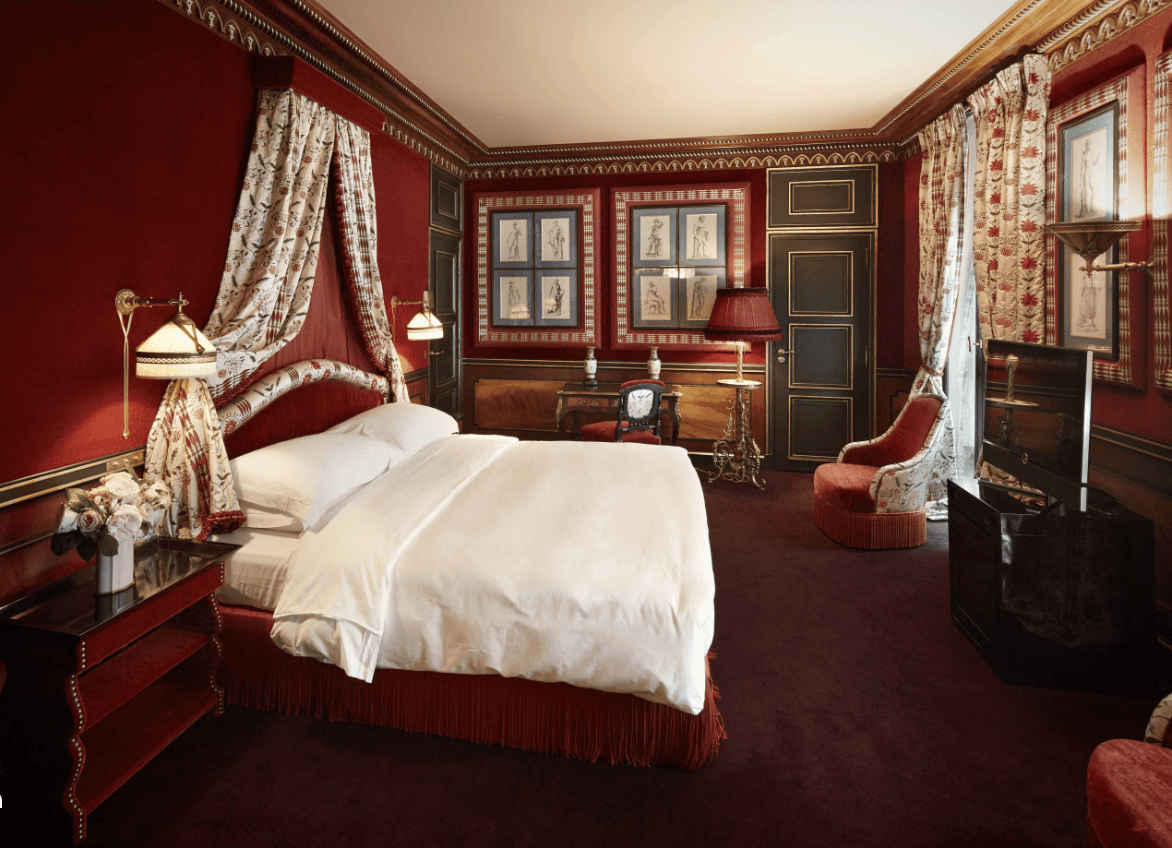
Hotel Costes
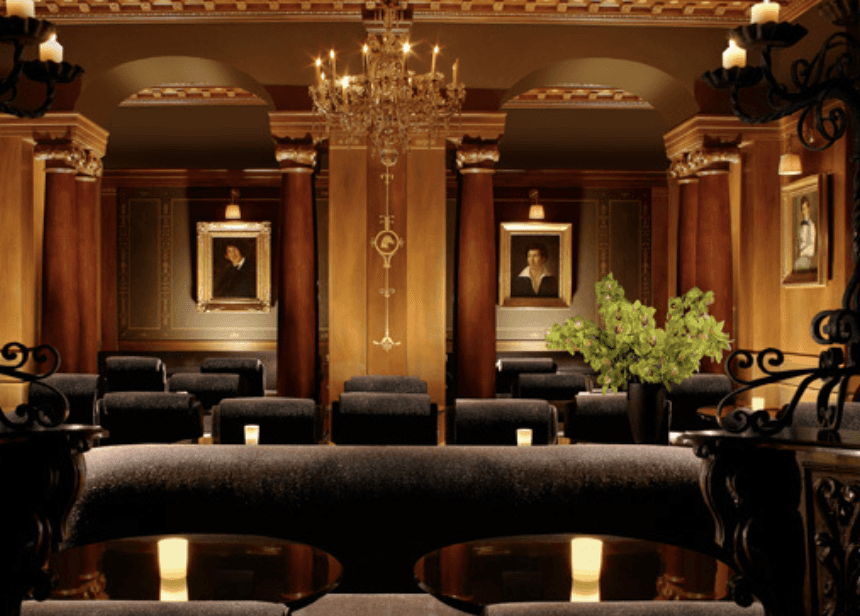
Hotel Costes
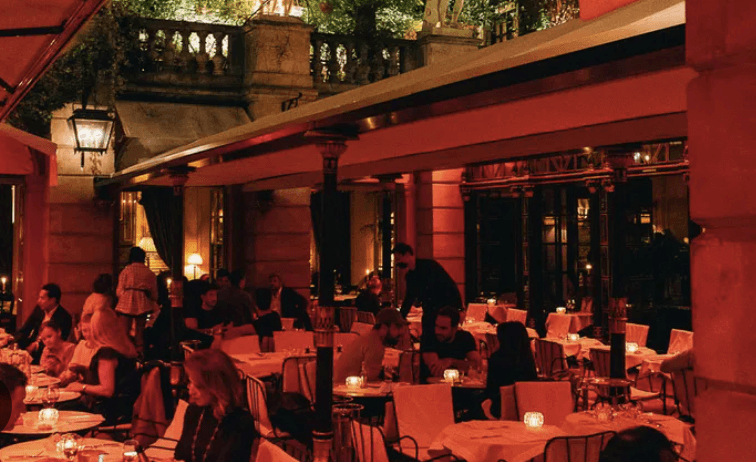
Hotel Costes
Hotel Costes
In 1984, Jean-Louis Costes, a young and ambitious guy from the Aveyron area, collaborated with Philippe Starck, an unknown underground designer, to develop a really unusual café. This café, which resembled a massive, transparent, and futuristic bubble, was unlike typical Parisian bistros and was placed in the 'les Halles' sector, a contentious neighbourhood undergoing a dramatic transformation. It became the place to be, attracting a large number of tourists and causing quite a fuss.
Jean-Louis Costes made a drastic move in 1995, opening the Hotel Costes on Rue Saint-Honoré, only a heartbeat from the Place Vendôme, one of Paris' most exquisite and lively squares. The décor was given to Jacques Garcia, who is noted for his finesse, combining elegance and baroque elements. Using his exquisite workmanship, the interior designer breathed new life into this 18th century home, transforming it into a completely unique 5-star hotel that defied the trends of the day. The interior exudes richness and theatricality, with innovative styles and features from several eras juxtaposed. For 25 years, Hotel Costes has been regarded as a timeless venue, typical of Parisian life, where diverse populations flow in and out throughout the day and night.
The rooms of Hotel Costes in Paris ooze timeless beauty and grandeur, capturing the essence of Parisian style. Each precisely constructed suite combines modern conveniences with traditional French aesthetics, including opulent furniture, rich textiles, and intricate embellishments. Guests are immersed in an opulent ambiance, complete with luxury facilities including marble baths, soft beds, and stylish décor. Soft lighting, carefully chosen artwork, and personalised touches create an atmosphere of luxury and elegance. Whether overlooking Paris's busy streets or the calm inner courtyard, each apartment provides a haven of peace in the middle of the city's chaos. Hotel Costes guarantees an exceptional stay for discerning travellers seeking the utmost in luxury accommodation.
The hotel boasts cosy dining rooms, a "5-star" chimney, light-filled galleries, and an Italian-style patio, making it a popular destination in Paris. Meals are offered around the clock at Hotel Costes. Jean-Louis Costes has designed a menu featuring his favourite meals. What are the results? The restaurant's classic gastronomy, mixed with a contemporary gourmet approach, has proven to be a huge success. This new generation gastronomic restaurant's menu features a wide variety of "signature" dishes made with seasonal ingredients, such as the delicious asparagus for a light lunch or the magnificent veal chop (limousine breed with full traceability) for an epicurean dinner. There's also "foie gras" that can be shared by two guests as a delightful snack. Savour a meal while listening to DJ performances that provide a carefree but glitzy musical ambiance.
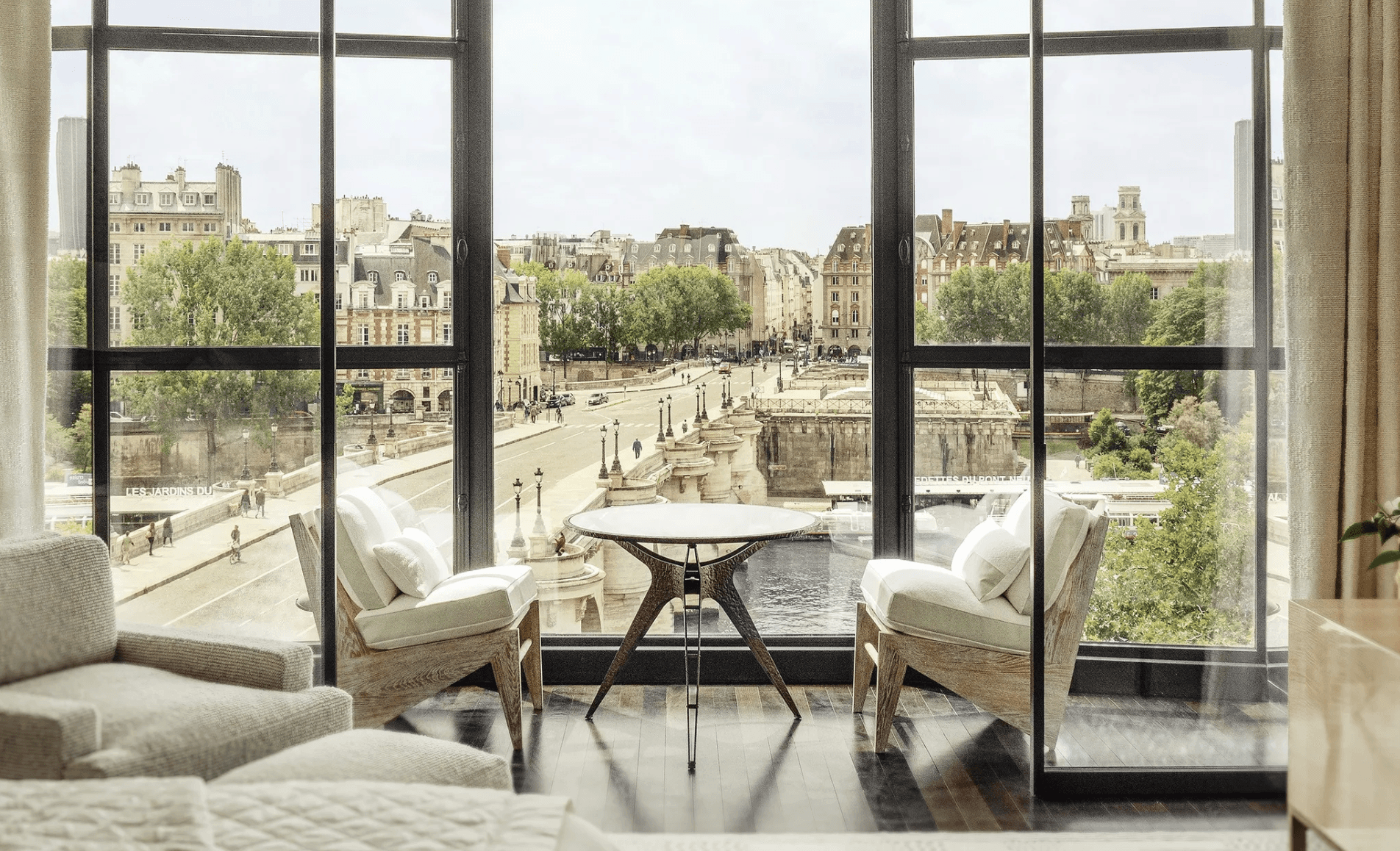
Cheval Blanc Paris

Cheval Blanc Paris
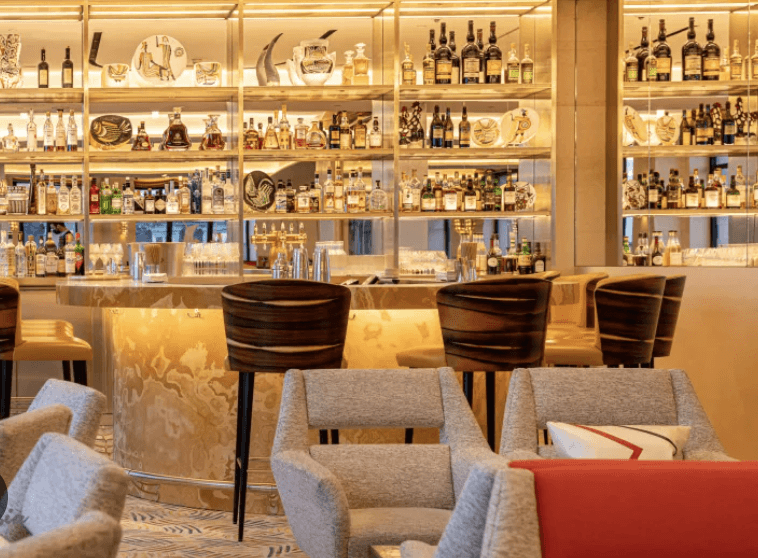
Cheval Blanc Paris
Cheval Blanc Paris
The hotel group of the brand, Cheval Blanc Maison, was established in the affluent ski resort town of Courchevel in 2006 and is named after a vineyard owned by LVMH in the renowned wine region of Saint-Emilion, France. This started a history of fusing classic elegance with regional architecture to produce some of the most exclusive homes in the world, where meticulous attention to detail is crucial. The second hotel owned by Louis Vuitton Moët Hennessy was located in the Maldives and was named after the posh locations of St Barths and Saint-Tropez in France. It seems appropriate to launch the company's first urban hotel within the storied La Samaritaine, close to where a large number of its customers live. The first hotel project designed by architect Peter Marino, who is familiar with the LVMH brand, was to create an unexpected destination. "I wanted everything to be fresh and surprising. It appeared to be the first time it was spotted. "Elegant, austere, and unique," comments Marino. It's no wonder that LVMH labels are everywhere, from Patou's gold-buttoned uniforms to Dior's underground spa.
Almost all of the 72 beautiful, beige and gold-hued rooms, 46 of which are suites, have views of the Seine. The best way to experience the hotel's lovely location is from a sunny winter garden suite. This exclusive perch provides views of Notre-Dame Cathedral and the Eiffel Tower, as well as a peep into daily life in the French city. This contains famous bouquinistes (booksellers), beautiful promenades, and maybe a quiet protest or two.
The bathrooms, which have big marble tubs and hammam walk-in showers, are enhanced with bath products in two distinct scents--one powdery fresh, the other deep and woody--designed by Dior fragrance François Demachy (in the shape of the building, no less) and look out over the river. The rooms' most opulent quality is shown in the details, from fridges allocated for cosmetics and makeup set at the appropriate temperature to prolong product shelf life to the unique light fixtures over each bed carved by artist Philippe Anthonioz. For those seeking absolute seclusion, the top floor duplex 7,000 square-foot Quintessence Suite has four ensuite bedrooms, a 41-foot private swimming pool, projection space, a panoramic terrace, and a high price tag, as one of Paris' biggest penthouses.
Introduction
Paris will always be one of the most beautiful cities in the world so it is no surprise that it is a bucket list destination for many people. If you are planning a trip to Paris and you are looking for a luxurious experience these are our 10 favourite hotels for that. We guarantee that you will be well looked after and that the memories you make on your stay will last a lifetime.

Hôtel de Crillon, A Rosewood Hotel

Hôtel de Crillon, A Rosewood Hotel

Hôtel de Crillon, A Rosewood Hotel
Hôtel de Crillon, A Rosewood Hotel
After an extensive and highly anticipated refurbishment, one of Paris's most beloved palace hotels has undergone a complete makeover. Her elegant 18th-century heart continues to beat briskly, but her pulse is quickening with the fresh 21st-century additions of sass, fizz, and zing.
One of the most luxurious hotels in Paris has been located in the 18th-century former Duke de Crillon home for more than a century, having been originally commissioned by King Louis XV. Things got even more extravagant in 2017 when the iconic establishment reopened as a Rosewood hotel. Under the direction of renowned Lebanese architect Aline Asmar d'Amman, a four-year transformation preserved the hotel's historic soul and gilded style while adding all the modern conveniences that modern travellers require.
Elevated public areas lead beyond the landmarked exterior, with a Corinthian column and Coustou statues, to 124 residential-style apartments and suites that pay homage to the mansion's former occupants. Discover a blend of handcrafted artwork, hand-picked objets d'art, antique and customised furnishings (such as bar carts in the old style), and modern accents like Bluetooth sound systems and 48-to 55-inch TVs. The 10 Specialty Suites elevate the experience to a higher level with their expansive living and dining spaces and more lavish furnishings, For example, the Suite Bernstein, named for the renowned composer, has an expansive terrace with views of the Place de la Concorde and the Eiffel Tower, while the Suite Duc de Crillon features original 18th-century woodwork from what was once the Crillon family chapel (the rest of the panelling currently resides at the Met in New York).
The warm and lively Nonos & Comestibles, a brasserie and deli run by triple-starred chef Paul Pairet, is a popular spot for all-day dining and pastry. Other culinary options include the cosy, one-star L'Ecrin, where Chef Boris Campanella's sophisticated pairing experiences let wines dictate the menu. The newest addition to the hotel's menu, Butterfly Pâtisserie, offers pastries for takeout or an extravagant tea time experience. Head pastry chef Mathieu Carlin creates all of the sweets particularly for this location.

The Ritz

The Ritz

The Ritz
The Ritz
With the help of French chef Auguste Escoffier and Swiss hotelier César Ritz, one of the most opulent hotels in the world was opened in 1898. At the time, each room had electricity, a private toilet and a telephone. Over the years, the Ritz became the preferred choice for many, including monarchs, queens, Marcel Proust, and Coco Chanel, who spent 34 years there. A suite is named after Chanel, and another frequent guest, Ernest Hemingway, is honoured on two other rooms and a bar. But even an icon needs a change of pace, so the hotel shuttered for the first time in its existence in 2012 and reopened four years later with new amenities, modern technology, and a lighter, brighter, yet still opulent aesthetic. There's still the big staircase winding up from the foyer, plenty of chandeliers and tufted seats, and staff members standing at attention in their uniforms.
With a colour palette of creams and light pinks or blues accentuated by rich brocades, Louis XV furniture, pastoral oil paintings, chandeliers, and trademark touches like key-shaped light switches and silk tulip lampshades, the 142 rooms and suites are spacious and exquisite. The Marcel Proust suite has a wall of vintage books, while the F. Scott Fitzgerald suite has a collection of global mementos. Each Prestige Suite is designed to honour its namesake. While most suites and rooms on higher floors include balconies or patios, all rooms feature marble fireplaces.
You may treat your taste senses in a number of locations, such as the glass-ceilinged Bar Vendôme brasserie, where you can try the Japanese breakfast in the morning, or the Salon Proust, which serves a sumptuous afternoon tea complete with deliciously spongey Madeleines.
If you're impressed by what you've tasted, enrol in a lesson at the L'Ecole Ritz Escoffier cooking school to improve your culinary skills (children's programmes are also available). Arrive early to the consistently crowded Bar Hemingway to get a spot, then indulge in some excellent people watching while sipping drinks. The Ritz Bar, which opened in September 2021, is a spectacular place with a lantern ceiling that serves glitzy drinks created by rising star mixologist Romain de Courcy, which are influenced by astrological signs.

Le Meurice, Dorchester Collection

Le Meurice, Dorchester Collection

Le Meurice, Dorchester Collection
Le Meurice, Dorchester Collection
Le Meurice is what you get when you imagine 18th-century luxury filtered through a Salvador Dalí artwork. Located near the Tuileries Garden, this renowned location was formerly home to Picasso's wedding feast and, most famously, was the residence of Salvador Dalí for more than thirty years. It debuted as one of the world's first luxury hotels in 1815. Knoll's Eero Saarinen Tulip chairs and portraits of 18th-century figures painted on the backs of leather seats are examples of classic elements that are balanced against the whimsical design of Dalí, which father-daughter design duo Philippe and Ara Starck looked to when renovating the Dorchester Collection hotel in 2016.
All of the rooms and suites of Charles Jouffre's hotel have been decorated in a French classical style, complete with plush carpets, classic furniture, antique accents, and fresh flowers. One unusual room even features a gabled ceiling and views of a peaceful courtyard. The design company Lally & Berger updated a number of lodgings between 2016 and 2019, giving the rooms a light, Versailles-inspired aesthetic. New suites were also shown, such as the four-bedroom duplex Belle Epoque, which boasts an unending rooftop patio and a Jacuzzi with views of Montmartre, and the Pompadour Suite, which has regal features like secret doors, a fireplace, oak parquet flooring, and custom carpets and furnishings.
The master chef exhibits his "Essential Cuisine" concept in the Michelin-starred Restaurant Le Meurice Alain Ducasse, while Le Dalí Restaurant specialises in hyper-seasonal and locally sourced French cuisine. Regulars fill Bar 228 with concoctions mixed by the renowned barman William Oliveri, among plush leather couches, dark wood panelling, jazz music and massive 1907 Lavalley murals. The results-driven products from Swiss brand Valmont are used in the jewel-box spa.

Shangri-La Paris

Shangri-La Paris

Shangri-La Paris
Shangri-La Paris
Napoleon's great-nephew, Prince Roland Bonaparte, selected a prominent location near the Seine River in 1891 and built a magnificent mansion with a spectacular "Stairway of Honour" fashioned from brass and forged steel, an intricately carved façade, and a vaulted ceiling decorated with zodiac symbols. The elegant prince was well-connected in Parisian intellectual, scientific, and artistic circles. He also held several exciting events at his castle, a custom that was brought back to life in 2010 with the inauguration of Shangri-La Paris. The structure was revitalised as well; following years of painstaking restoration work, it is now recognised as a historic landmark and has original wood flooring, stained glass windows, hand-carved mahogany panels, a marble entryway with a domed top, and the renowned staircase.
Given that half of the hotel's 100 rooms and suites have terraces and nearly all of them have views of the Eiffel Tower (some even from the bathtub), it should come as no surprise that this is a popular destination for anniversaries, honeymoons, and proposal ideas. The rooms have a cosy, domestic feel thanks to custom furniture, handy technology, and an Asian-meets-European design, which is represented in details like textured panelling and silk-thread wallpaper.
The marble bathrooms have heated floors, flat-screen TVs set into the fog-free mirrors, and both walk-in showers and deep soaking tubs—two ways to use the Guerlain bath products. The best part is that a lot of them have windows to bring in natural light and show off the views of the Eiffel.
The hotel is home to two of the city's most popular eating destinations: Shang Palace, the first Michelin-starred Chinese restaurant in France, and La Bauhinia, which provides a sophisticated East-meets-West cuisine that includes the well-liked afternoon tea, under the central glass cupola. Taking its name after Prince Roland's preferred field of study, the swanky Le Bar Botaniste offers a selection of uncommon botanical alcoholic beverages, complete with an absinthe fountain. Located in the ancient stables of the castle, the spa soothes with lovely indoor pool and scented treatments.

Four Seasons Hotel George V, Paris

Four Seasons Hotel George V, Paris

Four Seasons Hotel George V, Paris
Four Seasons Hotel George V, Paris
This hotel is a true Paris institution, having debuted in 1928 and situated in the ever-so-chic eighth district. However, as soon as you walk in, you realise that things are not as conventional as they appear. Although the staff is kind and professional (and always knows your name), the big and gilded foyer prevents the establishment from being stuffy. Instead, it is infused with modern flair and an edgy attitude. For example, consider the striking lobby installations by renowned florist and designer Jeff Leatham, which might feature enormous plexiglass reindeer in the winter or exquisite, toppling flower arrangements in the spring. Pop-ups in the courtyard, such as a winter 'igloo' with an ice bar, give the location a lively vibe that sets it apart from many other hotels with palace designations.
The 244 rooms and suites are the ideal Paris pied-à-terre, complete with a living room decorated in the Louis XVI style, an enormous walk-in closet, and separate bathrooms with views of the Eiffel Tower. Even the entry-level categories are rather roomy by city standards, with a traditional décor of Louis XV-style furniture, subdued colour palettes, and (for the most part) balconies or patios. The suites, on the other hand, are full of enchanted details; depending on the kind, you may make supper for six people in your fully equipped kitchen, enjoy chandeliers and walls covered in fabric, or toast with champagne on the terrace of your duplex.
With double vanities, big bathtubs, power showers, and thick terry cloth robes, the marble bathrooms are spacious and provide plenty space for unwinding. Aromatherapy pods are available for some of the showers, and they may be fixed to the nozzles to create a soothing sensory experience.
This is Europe's first hotel with five Michelin stars under one roof, earned by three separate restaurants. There's the fine dining Le Cinq, where French classics are recreated with lighter ingredients and techniques; the colourful and trendy Le George, with Mediterranean-influenced dishes and plenty of half-portion options; and the exquisite L'Orangerie, which serves contemporary Gallic cuisine. All restaurants use top vintages from the hotel's famed, approximately 50,000-bottle cellar, which was able to withstand World War II bombardment thanks to its location 45 feet underground. High tea is served in La Galerie, surrounded by 19th-century paintings and Flemish tapestries, while cocktails and single malts may be drunk in the wood-paneled Le Bar, which overlooks the tree-lined Avenue George V. The spa has a hair salon, a high-tech gym, and treatments utilising high-end Swiss skin care products; a pool, sauna, and steam hammam complete the soothing experience.

La Réserve Paris - Hotel and Spa

La Réserve Paris - Hotel and Spa

La Réserve Paris - Hotel and Spa
La Réserve Paris - Hotel and Spa
Past the Haussmann-style façade and a flaming red entrance, you enter a world of elegant 19th-century beauty combined with fully contemporary accents. La Réserve Paris, which opened in 2015 in a palace originally owned by Napoleon's stepbrother, the Duc of Morny, was designed by interiors master Jacques Garcia in his characteristic style, with plenty of velvet draperies, silk damask walls, gold frames, and herringbone parquet flooring. The public areas encourage relaxation, with long, pillow-strewn sofas and plush upholstered club chairs arranged around ornate fireplaces and shelves lined with over 3,000 antique books; an intimate garden lounge makes the city seem far away, despite the property's proximity to the Champs-Élysées and Avenue Montaigne.
Electronic check-in and iPad control centres for temperature, lighting, and entertainment in the rooms help to counter the dreamlike extravagance. The décor varies throughout the 40 rooms (more than half of which are suites), but is usually more subdued than the lobby areas, with neat, plain beds complemented with velvet arm chairs, hand-picked antiques, and billowing damascene brocade taffeta. Many feature floor-to-ceiling windows or private patios that overlook metropolitan landmarks.
The enormous bathrooms, which are filled with natural light, are finished in Carrara and Turquin blue marble and have double vanities, separate tubs, and Italian showers.
The details are what really stand out, from linens embroidered with guests' names and a jewellery box in the hotel's distinctive deep red to different colours for men's and women's bathrobes (slate for him, blush for her), and hand weights and stretch bands provided for in-room exercise. Mini-bars stock wine from the hotel's estates. Each room has a butler who will make sure your bedside tables are stocked with books by your favourite authors, draw you a bath, or assist you with packing, and who can also organise exceptional events such as in-suite private concerts, couture fittings, and custom perfume creation sessions.
Given the hotel's tiny size, the recreational amenities are substantial: a 52-foot lap pool, a gym with personal trainer, and a three-room spa with customised treatments from the Nescens-Swiss anti-aging brand. The two-Michelin-star Le Gabriel reinterprets classic French fine dining with a Japanese twist, whilst La Pagode de Cos reinterprets meals from across the world in a space gilded with carved woodwork and a large fireplace. The stunning Duc de Mornay Library, which will be unveiled in 2021, is only available to hotel guests in the morning before opening to the public for lunch on the patio or around the fire, tea in the afternoon (perhaps paired with one of the over 3,000 books on the shelves), and drinks from the honour bar in the evening. Be sure to taste some Bordeaux from the hotel's vineyards, and don't miss the "secret" entrance to the smoking area, which has 400 cigars. Finally, Bar Le Gaspard, a local favourite, has a large wine and cocktail selection, as well as bartenders who can build a drink according to your preferences—and will remember the recipe the next time you visit.

Hôtel Le Grand Mazarin

Hôtel Le Grand Mazarin

Hôtel Le Grand Mazarin
Hôtel Le Grand Mazarin
Le Grand Mazarin, from the Maisons Pariente line, stands out for its eclectic and maximalist style by Swedish designer Martin Brudnizki. Rather than being inspired by Louis XIV's minister Cardinal Mazarin, the hotel was influenced by 17th-century literary salons. The hotel, which has over 500 meticulously collected artworks by Amélie du Chalard, including trompe-l'oeil windows by Sophia Pega and a beautiful fresco by Jacques Merle, provides a compelling combination of food, beverages, and creativity. This makes it a standout location in Paris, where guests can immerse themselves in a world of culture and elegance.
The Wes Anderson meets Alice in Wonderland literary salon feel is most evident in each of the 50 guest rooms and 11 suites, some of which have individual balconies with views of the BHV/Marais and the neighbourhood. Because of the ancient 14th-century edifice they occupy, each is naturally unique in design and arrangement, but this only adds to its attractiveness. Brudnizki's take on French classicism employs disparate motifs, colours, and fabrics that work well together, aided by the craftsmanship of the talented artisans he hired to complete each piece, many of whom work for companies bearing the French Living Heritage label (Entreprises du Patrimoine Vivant). The plush carpets were created by Manufacture Pinton 1867, the quirky fabrics by Maison Pierre Frey, and the custom lamps with hand-decorated legs and shades by two different artists, Laura Horrocks and Claudia Cauville.
The design varies each room, but there are a few common threads: the room is built up around a huge bed with an Aubusson-style tapestry from Art de Lys as a canopy. Mini bars offer locally sourced snacks, coffee capsules from Café Joyeux, a French coffee shop chain that employs people with disabilities, and a selection of beauty products curated by the Parisian concept store Oh My Cream, all of which can be ordered and delivered to rooms within 30 minutes by a butler. Diptyque bath items line the vanity in every bathroom. Mini bars offer locally sourced snacks, coffee capsules from Café Joyeux, a French coffee shop chain that employs people with disabilities, and a selection of beauty products curated by the Parisian concept store Oh My Cream, all of which can be ordered and delivered to rooms within 30 minutes by a butler. Diptyque bath items line the vanity in every bathroom.
In terms of cuisine and wine, chef Assaf Granit's award-winning crew is difficult to top. Granit's group JLM Machneyuda, which already owns one Michelin-starred restaurant Shabour, Tekés (vegetarian), Shana, and the recently reopened Kapara (previously Balagan), now adds Boubalé to its little global empire. It's also the first restaurant in the group to try an Israeli take on Ashkenazi cuisine (the menu includes items that aren't truly Ashkenazi, such as seafood kneidlach or matzo balls), as well as a few other dishes inspired by Moroccan, Syrian, or Iraqi Sephardic cooking, which many of his cooks grew up eating and preparing firsthand.

Hotel Costes

Hotel Costes

Hotel Costes
Hotel Costes
In 1984, Jean-Louis Costes, a young and ambitious guy from the Aveyron area, collaborated with Philippe Starck, an unknown underground designer, to develop a really unusual café. This café, which resembled a massive, transparent, and futuristic bubble, was unlike typical Parisian bistros and was placed in the 'les Halles' sector, a contentious neighbourhood undergoing a dramatic transformation. It became the place to be, attracting a large number of tourists and causing quite a fuss.
Jean-Louis Costes made a drastic move in 1995, opening the Hotel Costes on Rue Saint-Honoré, only a heartbeat from the Place Vendôme, one of Paris' most exquisite and lively squares. The décor was given to Jacques Garcia, who is noted for his finesse, combining elegance and baroque elements. Using his exquisite workmanship, the interior designer breathed new life into this 18th century home, transforming it into a completely unique 5-star hotel that defied the trends of the day. The interior exudes richness and theatricality, with innovative styles and features from several eras juxtaposed. For 25 years, Hotel Costes has been regarded as a timeless venue, typical of Parisian life, where diverse populations flow in and out throughout the day and night.
The rooms of Hotel Costes in Paris ooze timeless beauty and grandeur, capturing the essence of Parisian style. Each precisely constructed suite combines modern conveniences with traditional French aesthetics, including opulent furniture, rich textiles, and intricate embellishments. Guests are immersed in an opulent ambiance, complete with luxury facilities including marble baths, soft beds, and stylish décor. Soft lighting, carefully chosen artwork, and personalised touches create an atmosphere of luxury and elegance. Whether overlooking Paris's busy streets or the calm inner courtyard, each apartment provides a haven of peace in the middle of the city's chaos. Hotel Costes guarantees an exceptional stay for discerning travellers seeking the utmost in luxury accommodation.
The hotel boasts cosy dining rooms, a "5-star" chimney, light-filled galleries, and an Italian-style patio, making it a popular destination in Paris. Meals are offered around the clock at Hotel Costes. Jean-Louis Costes has designed a menu featuring his favourite meals. What are the results? The restaurant's classic gastronomy, mixed with a contemporary gourmet approach, has proven to be a huge success. This new generation gastronomic restaurant's menu features a wide variety of "signature" dishes made with seasonal ingredients, such as the delicious asparagus for a light lunch or the magnificent veal chop (limousine breed with full traceability) for an epicurean dinner. There's also "foie gras" that can be shared by two guests as a delightful snack. Savour a meal while listening to DJ performances that provide a carefree but glitzy musical ambiance.

Cheval Blanc Paris

Cheval Blanc Paris

Cheval Blanc Paris
Cheval Blanc Paris
The hotel group of the brand, Cheval Blanc Maison, was established in the affluent ski resort town of Courchevel in 2006 and is named after a vineyard owned by LVMH in the renowned wine region of Saint-Emilion, France. This started a history of fusing classic elegance with regional architecture to produce some of the most exclusive homes in the world, where meticulous attention to detail is crucial. The second hotel owned by Louis Vuitton Moët Hennessy was located in the Maldives and was named after the posh locations of St Barths and Saint-Tropez in France. It seems appropriate to launch the company's first urban hotel within the storied La Samaritaine, close to where a large number of its customers live. The first hotel project designed by architect Peter Marino, who is familiar with the LVMH brand, was to create an unexpected destination. "I wanted everything to be fresh and surprising. It appeared to be the first time it was spotted. "Elegant, austere, and unique," comments Marino. It's no wonder that LVMH labels are everywhere, from Patou's gold-buttoned uniforms to Dior's underground spa.
Almost all of the 72 beautiful, beige and gold-hued rooms, 46 of which are suites, have views of the Seine. The best way to experience the hotel's lovely location is from a sunny winter garden suite. This exclusive perch provides views of Notre-Dame Cathedral and the Eiffel Tower, as well as a peep into daily life in the French city. This contains famous bouquinistes (booksellers), beautiful promenades, and maybe a quiet protest or two.
The bathrooms, which have big marble tubs and hammam walk-in showers, are enhanced with bath products in two distinct scents--one powdery fresh, the other deep and woody--designed by Dior fragrance François Demachy (in the shape of the building, no less) and look out over the river. The rooms' most opulent quality is shown in the details, from fridges allocated for cosmetics and makeup set at the appropriate temperature to prolong product shelf life to the unique light fixtures over each bed carved by artist Philippe Anthonioz. For those seeking absolute seclusion, the top floor duplex 7,000 square-foot Quintessence Suite has four ensuite bedrooms, a 41-foot private swimming pool, projection space, a panoramic terrace, and a high price tag, as one of Paris' biggest penthouses.


